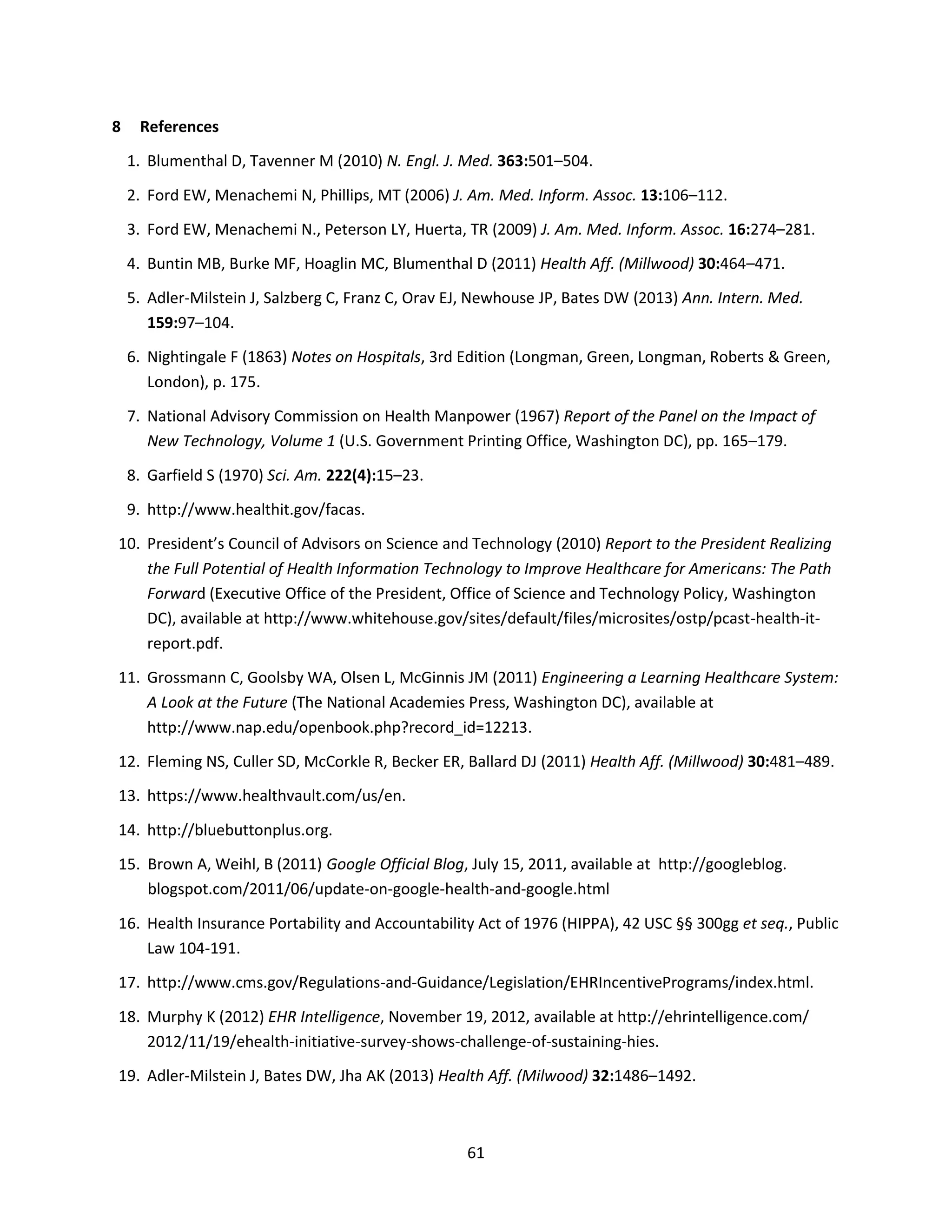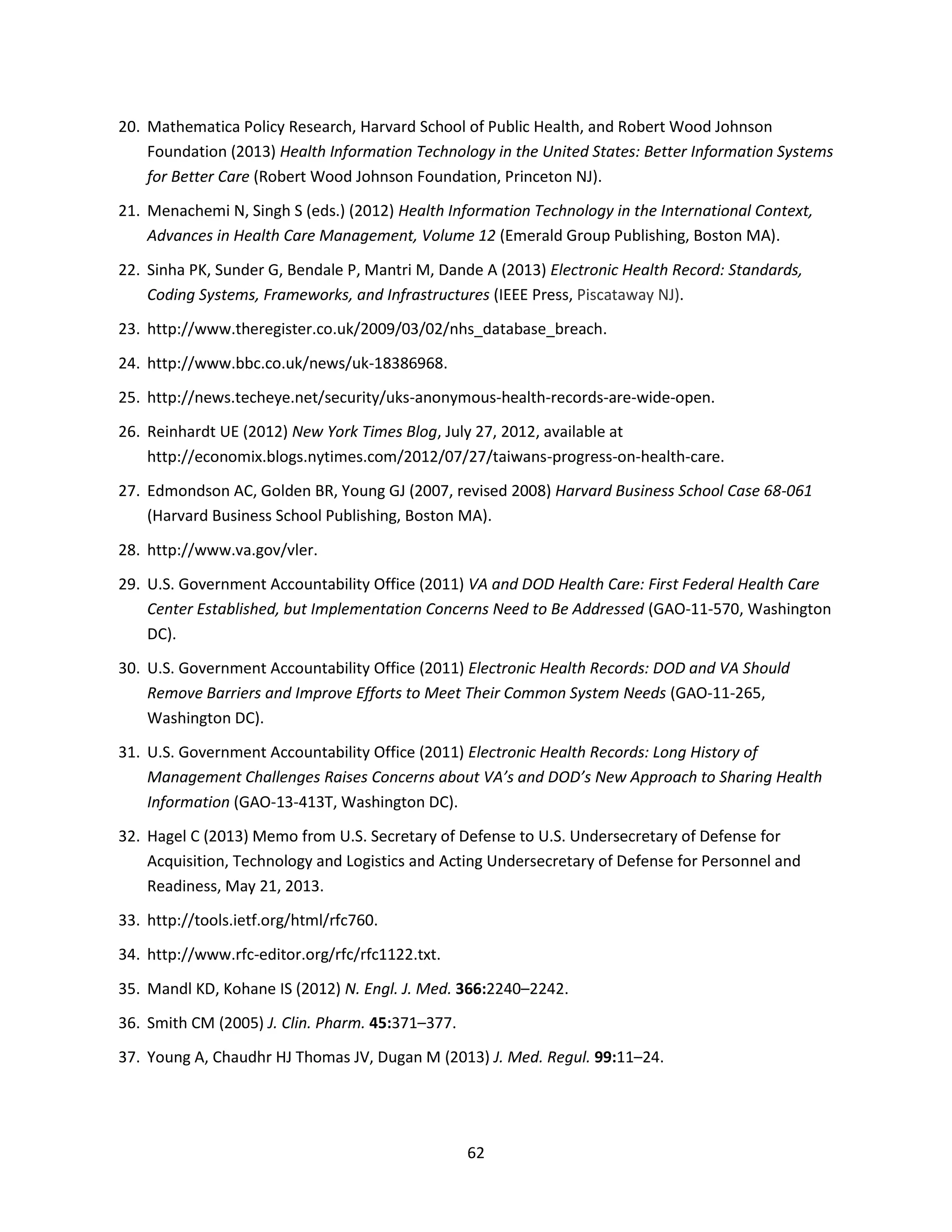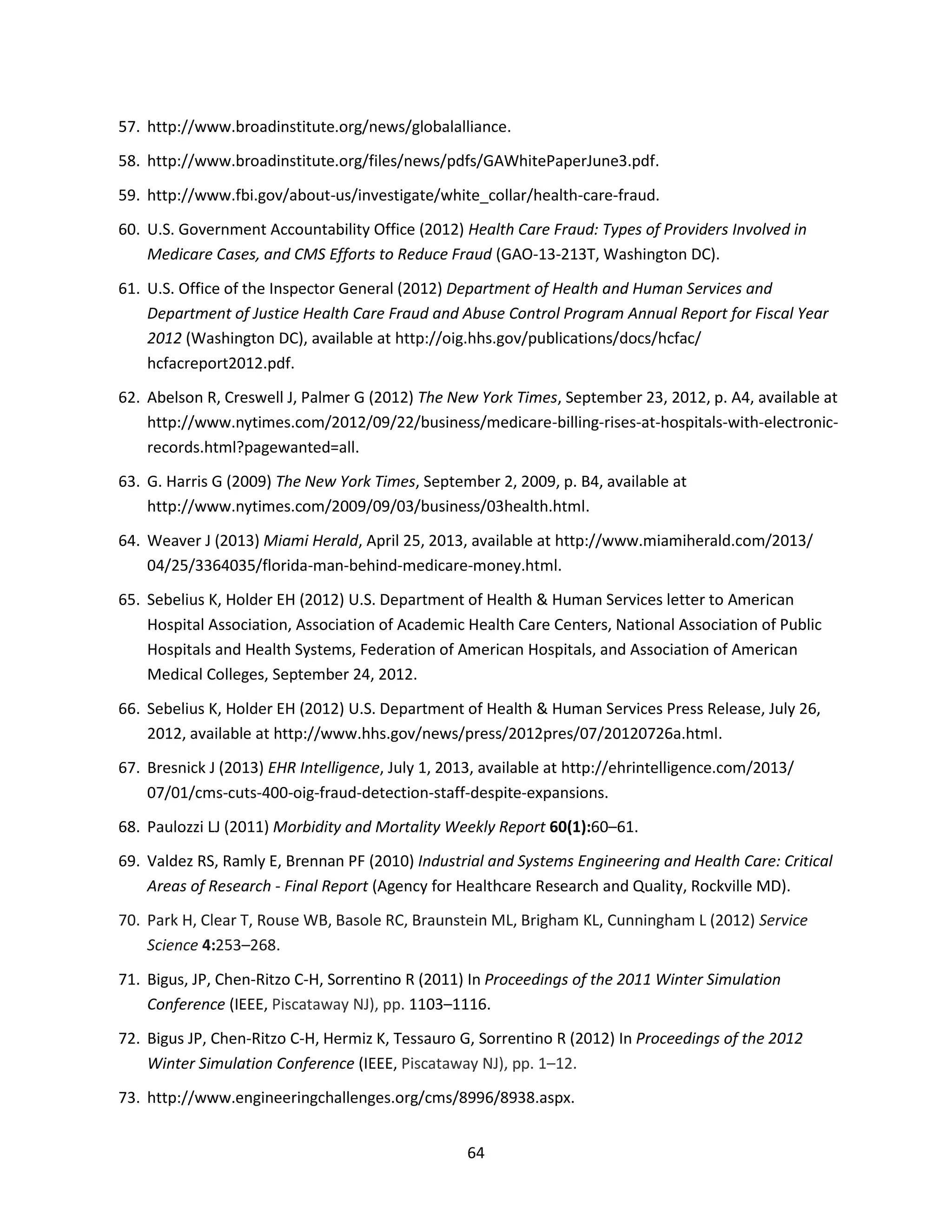The document outlines the challenges and potential benefits of establishing a robust health data infrastructure in the U.S., emphasizing the importance of electronic health records (EHRs) and health information exchanges (HIEs) for improving care quality and reducing costs. It discusses the need for a new software architecture that ensures interoperability, protects patient privacy, and enhances data access for both healthcare providers and patients. The findings highlight that the current lack of interoperability remains a significant barrier, necessitating comprehensive efforts to achieve meaningful health data exchange.
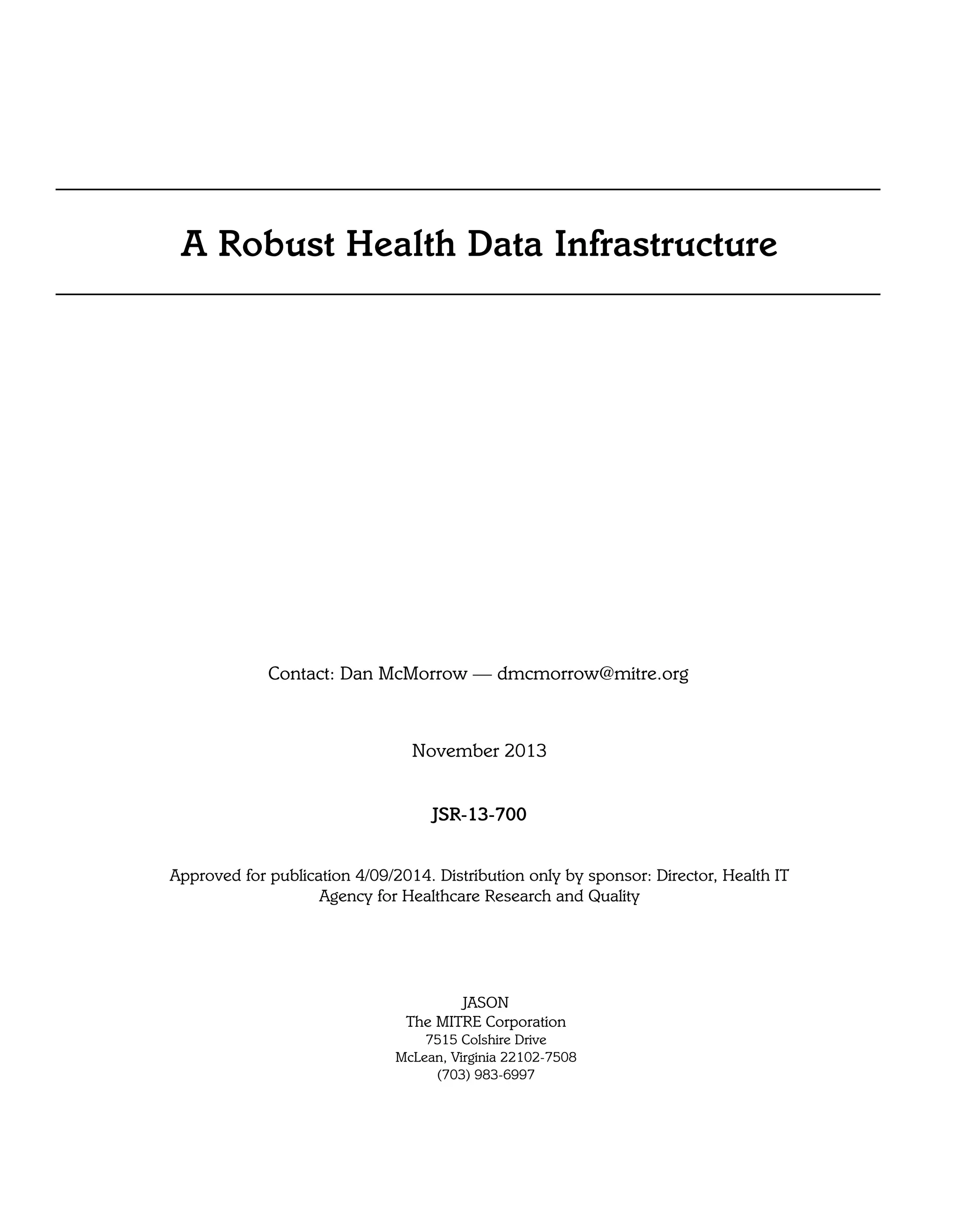
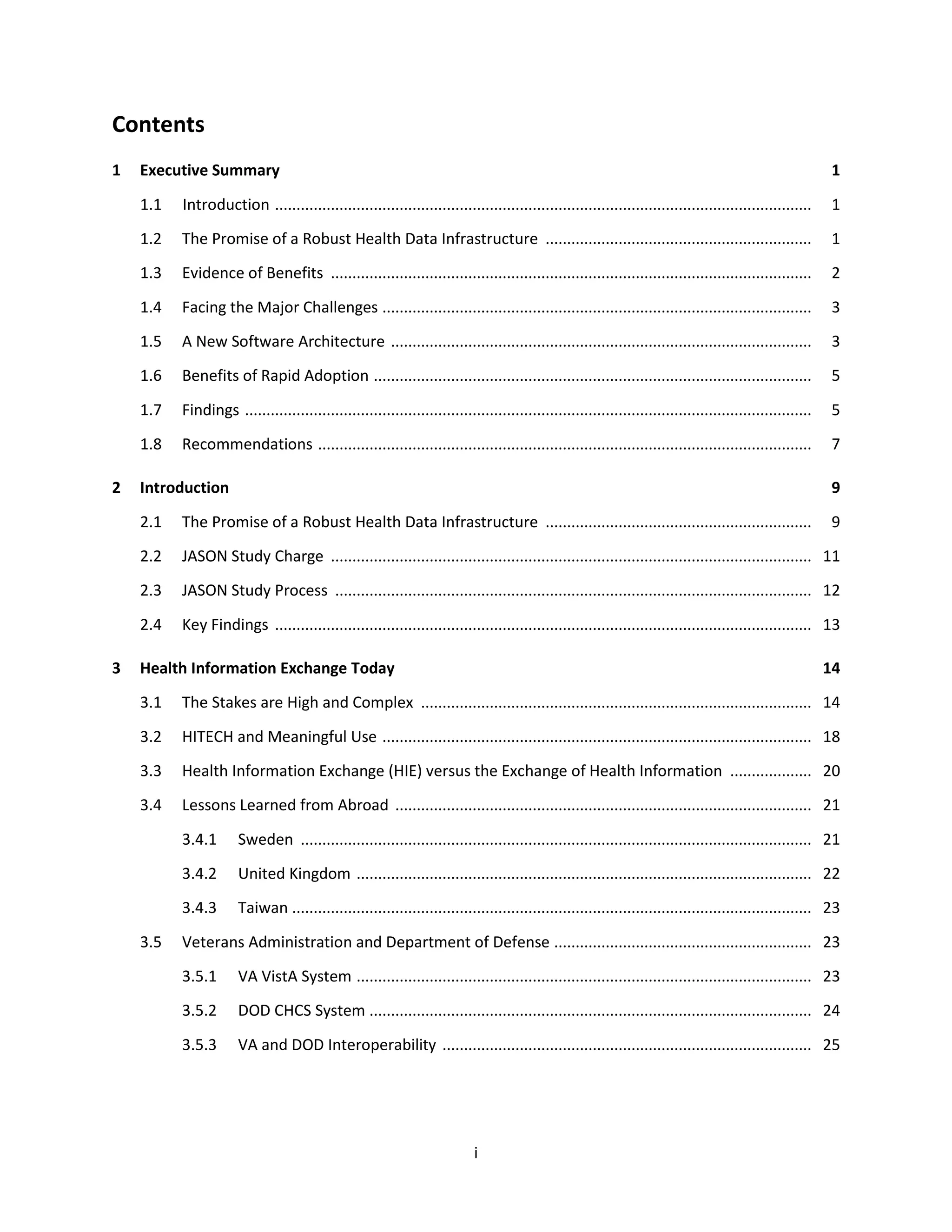
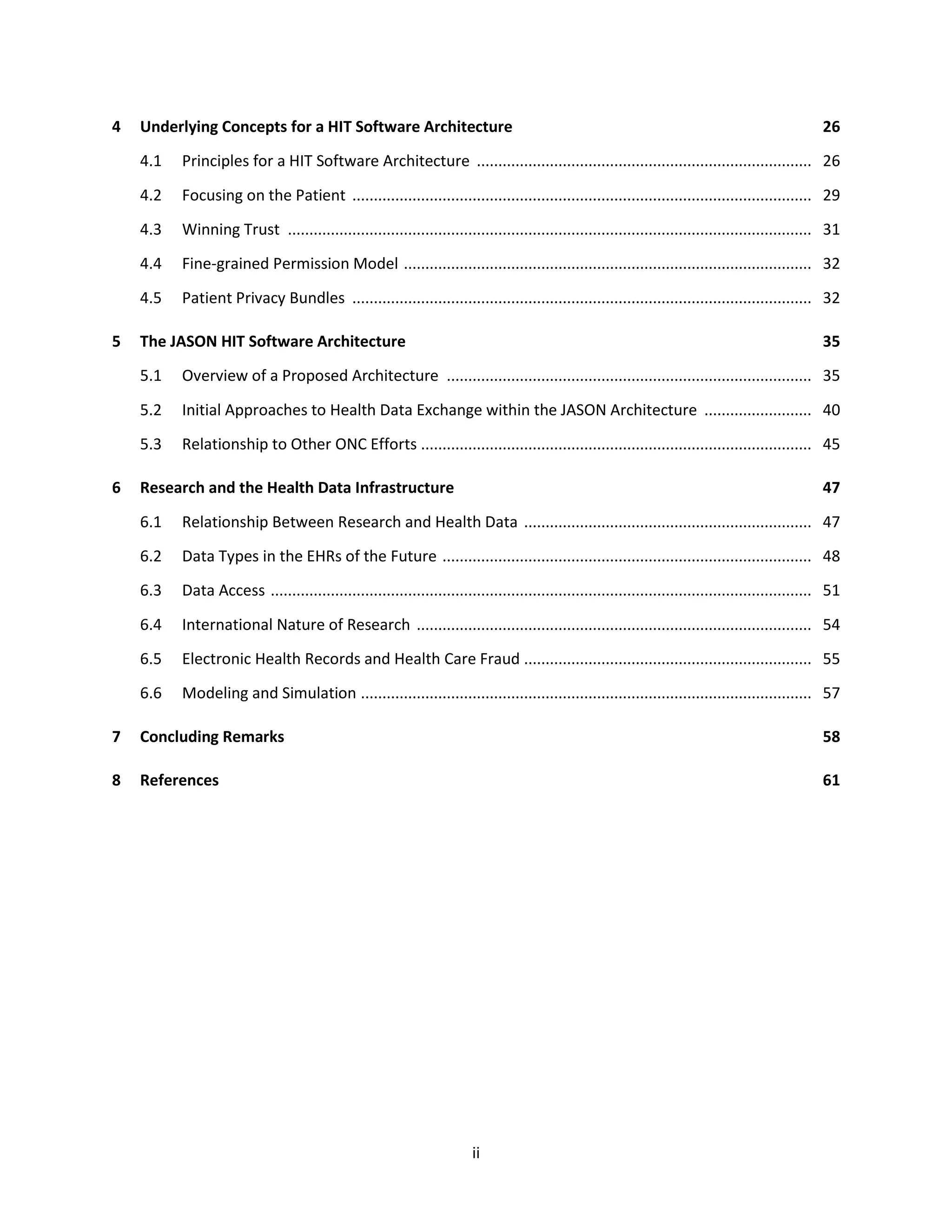
![1
1 Executive Summary
1.1 Introduction
The promise of improving health care through the ready access and integration of health data has
drawn significant national attention and federal investment. David Blumenthal (former National
Coordinator for Health Information Technology) and Marilyn Tavenner (current Administrator for the
Centers for Medicare & Medicaid Services, CMS) have characterized the situation well:
“The widespread use of electronic health records in the United States is inevitable. EHRs will improve
caregivers’ decisions and patients’ outcomes. Once patients experience the benefits of this technology,
they will demand nothing less from their providers. Hundreds of thousands of physicians have already
seen these benefits in their clinical practice.
But inevitability does not mean easy transition. We have years of professional agreement and bipartisan
consensus regarding the potential value of EHRs. Yet we have not moved significantly to extend the
availability of EHRs from a few large institutions to the smaller clinics and practices where most Americans
receive their health care.” [1]
The two overarching goals of moving to the electronic exchange of health information are improved
health care and lower health care costs. Whether either, or both, of these goals can be achieved
remains to be seen, and the challenges are immense. Health care is one of the largest segments of the
US economy, approaching 20% of GDP. Despite the obvious technological aspects of modern medicine,
it is one of the last major segments of the economy to become widely accepting of digital information
technology, for a variety of practical and cultural reasons. That said, the adoption of electronic records
in medicine has been embraced, particularly by health care administrators in the private sector and by
the leaders of agencies of the federal and state governments with responsibility for health care.
Although the transition to electronic records now seems a foregone conclusion, it is beset by many
challenges, and the form and speed of that transition is uncertain. Furthermore, there are questions
about whether that transition will actually improve the quality of life, in either a medical or economic
sense.
1.2 The Promise of a Robust Health Data Infrastructure
In principle, a combination of electronic health records (EHRs) and improved exchange of health
information could serve a number of useful purposes. Frequently cited benefits include:
Satisfy the growing demand of patients for flexible access to their own health information
Offer faster, interoperable access to patient records by health care providers
Reduce errors within individual records and across records
Reduce redundant testing and diagnostic procedures
Produce more complete health records and more accurate health data](https://image.slidesharecdn.com/health-data-140720040559-phpapp02/75/A-Robust-Health-Data-Infrastructure-JASON-2013-4-2048.jpg)
![2
Promote better longitudinal tracking of patients and patient groups
Promote improved standards of care and reduce the incidence of errors in clinical practice
Provide research data of unprecedented power to inform clinical care, public health, and
biomedical research
Facilitate better communication among health care providers and patients
Enable electronic detection of health care fraud
Improve tracking of health care costs and benefits, thereby enhancing understanding of the
economics of health care delivery.
Whether any of these benefits can be realized depends not only on the framework for health
information technology and exchange, but also on the details of any such implementation. It is therefore
vitally important to get those details right.
1.3 Evidence of Benefits
Evidence has been slow to accumulate that the widespread use of EHRs and health information
exchanges (HIEs) actually improves the quality, safety, or efficiency of health care in the US. This lack of
evidence is partly attributable to slower-than-anticipated adoption rates of computerized health
information technology (HIT) systems, especially among small health care organizations and individual
providers [2,3]. EHR adoption has been incentivized by HITECH (Health Information Technology for
Economic and Clinical Health), a program that was part of the American Recovery and Reinvestment Act
of 2009. That program has made more than $15.5 billion available (through July 2013) to hospitals and
health care professionals based on their meeting certain EHR benchmarks for so-called “meaningful
use.” HITECH funds also were used to stand up hundreds of HIEs with the goal of mobilizing the
information contained in EHRs. Collectively, these efforts are one of the largest investments in health
care infrastructure ever made by the federal government.
The evidence for modest, but consistent, improvements in health care quality and safety is growing,
especially over the last few years [4]. Evidence has recently emerged to indicate that EHRs can indeed
reduce the costs of health care in the general community setting, and not just in an academic hospital
and its affiliated practices or in a large-scale health care enterprise. A recent study of 180,000
outpatients and 800 clinicians in communities that had adopted EHRs from multiple vendors found that,
over a multi-year period, the overall cost of outpatient care was reduced by 3.1% relative to the control
group [5]. These and other encouraging findings suggest the potential for improved efficiency program-
wide.
1.4 Facing the Major Challenges
A meaningful exchange of information, electronic or otherwise, can take place between two parties
only when the data are expressed in a mutually comprehensible format and include the information that](https://image.slidesharecdn.com/health-data-140720040559-phpapp02/75/A-Robust-Health-Data-Infrastructure-JASON-2013-5-2048.jpg)
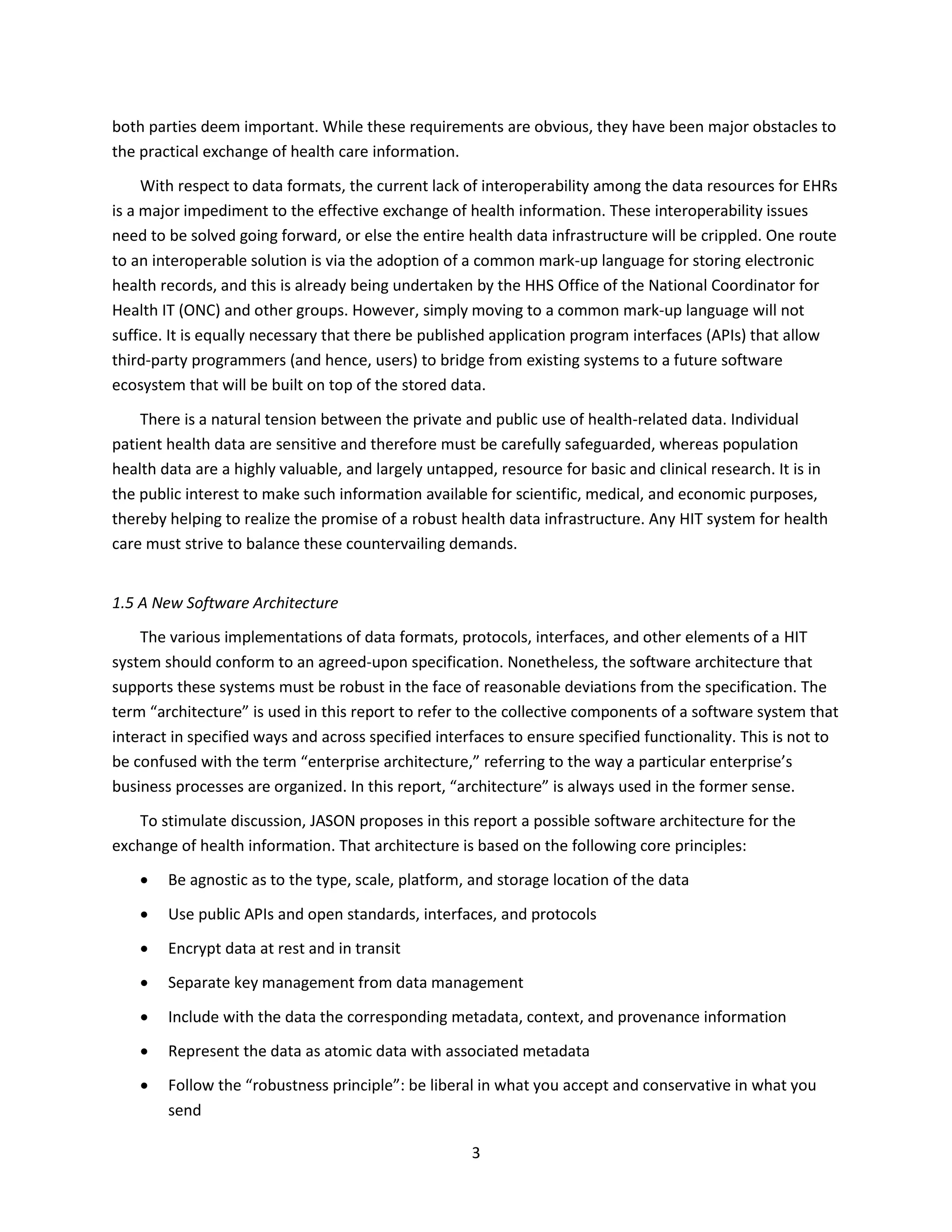
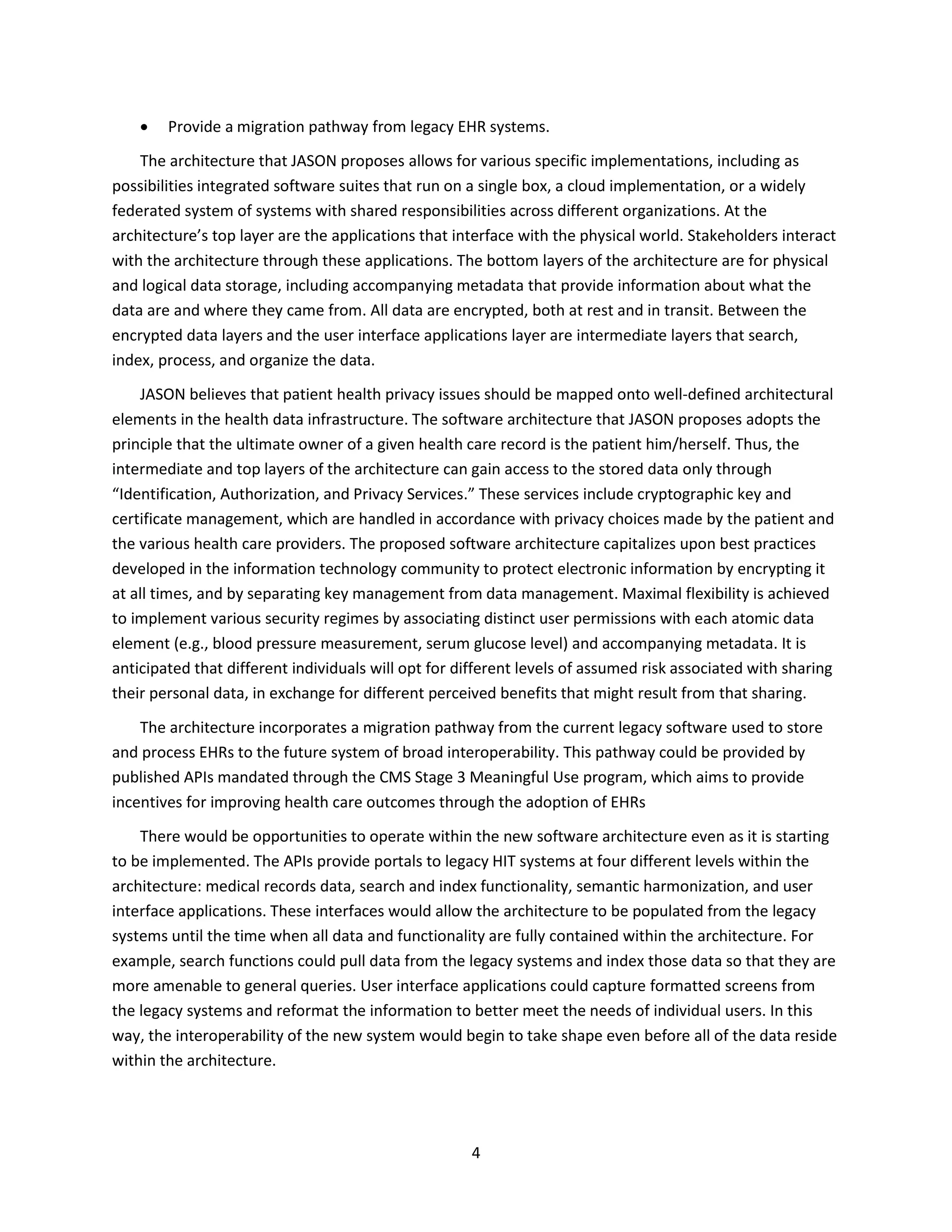

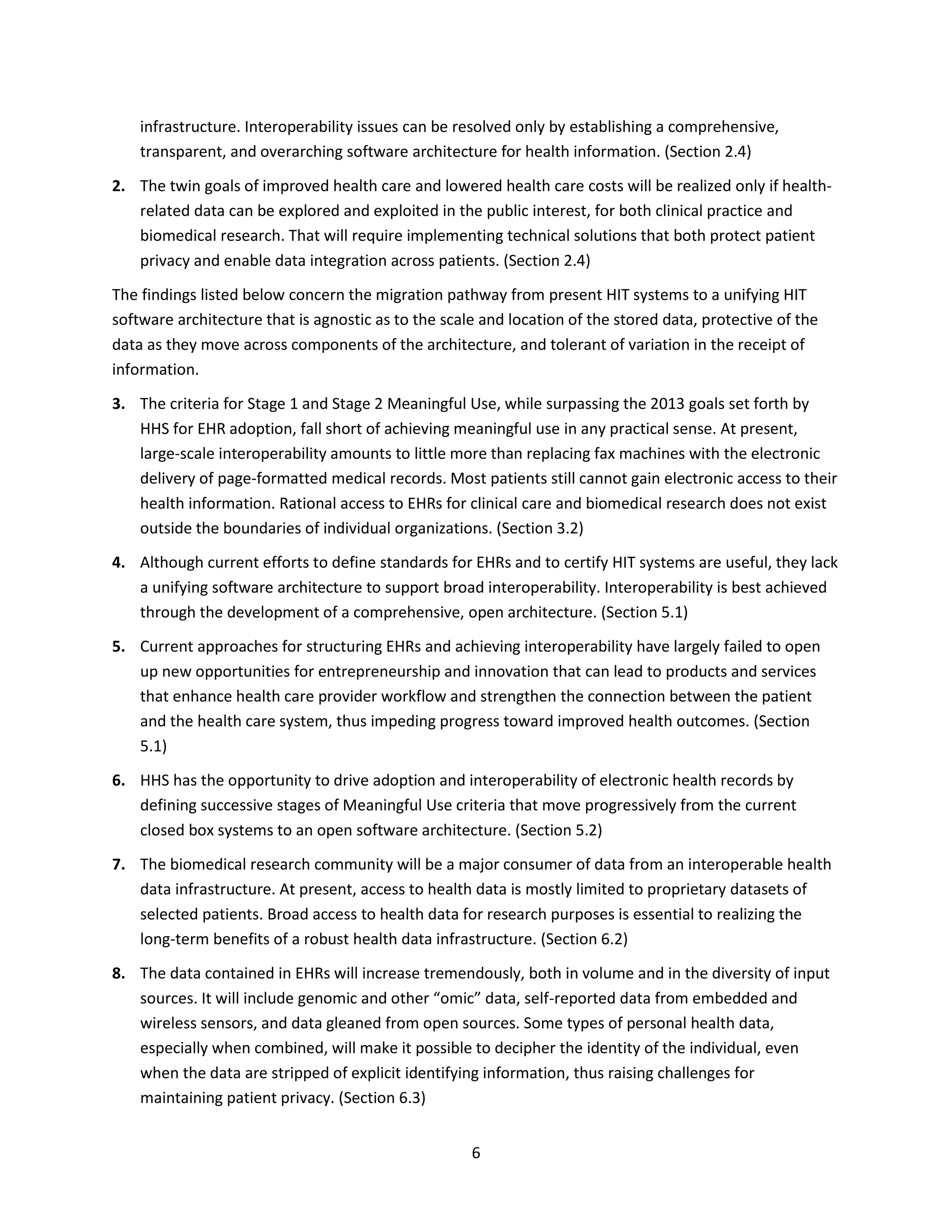
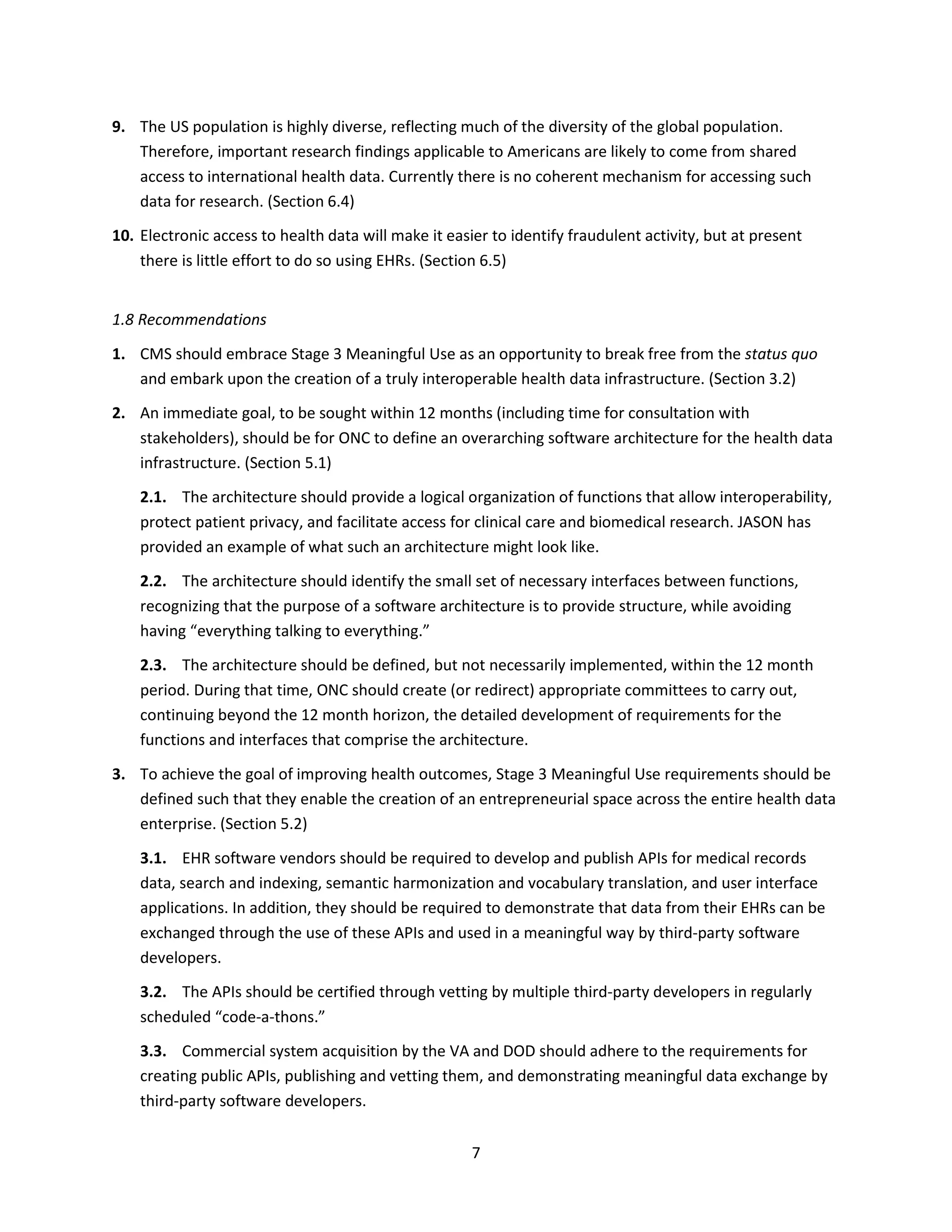

![9
2 Introduction
An electronic health record (EHR) is a longitudinal digital record of an individual’s health
information. There are many different motivations for moving to EHRs and the electronic exchange of
health information, and these tend to vary depending on the person or agency within the overall health
care system. However, the two overarching goals most commonly associated with the increased use of
health information technology (HIT) are improved health care and lower health care costs. Whether
either, or both, of these goals can be achieved remains to be seen, and the challenges are immense.
Health care is one of the largest segments of the US economy, approaching 20% of GDP. Despite the
obvious technological aspects of modern medicine, it is one of the last major segments of the economy
to become widely accepting of digital information technology, for a variety of practical and cultural
reasons. That said, the adoption of electronic records in medicine has been embraced, particularly by
health care administrators in the private sector and by the leaders of agencies of the federal and state
governments with responsibility for health care. Although the transition to electronic records now
seems a foregone conclusion, it is beset by many challenges, and the form and speed of that transition is
uncertain. Furthermore, there are questions about whether that transition will actually improve the
quality of life, in either a medical or economic sense.
The situation was well summarized in a 2010 Perspective in the New England Journal of Medicine by
David Blumenthal (former National Coordinator for Health Information Technology) and Marilyn
Tavenner (current Administrator for the Centers for Medicare & Medicaid Services, CMS) [1]:
“The widespread use of electronic health records in the United States is inevitable. EHRs will improve
caregivers’ decisions and patients’ outcomes. Once patients experience the benefits of this technology,
they will demand nothing less from their providers. Hundreds of thousands of physicians have already
seen these benefits in their clinical practice.
But inevitability does not mean easy transition. We have years of professional agreement and bipartisan
consensus regarding the potential value of EHRs. Yet we have not moved significantly to extend the
availability of EHRs from a few large institutions to the smaller clinics and practices where most Americans
receive their health care.”
2.1 The Promise of a Robust Health Data Infrastructure
The promise of improving health care through the ready access and integration of health data and
records has been offered for nearly 150 years, beginning with Florence Nightingale in 1863 [6]:
“In attempting to arrive at the truth, I have applied everywhere for information but scarcely an instance
have I been able to obtain hospital records fit for any purpose of comparison. If they could be obtained
they would enable us to decide many other questions besides the ones alluded to. They would show
subscribers how their money was spent, what amount of good was really being done with it or whether
their money was not doing mischief rather than good.”](https://image.slidesharecdn.com/health-data-140720040559-phpapp02/75/A-Robust-Health-Data-Infrastructure-JASON-2013-12-2048.jpg)
![10
Yet more than a century after Florence Nightingale pointed out the obvious benefit of broad access
to and integration of health records, health care still had not been empowered with such information. In
1967 a cry went out from the National Advisory Commission on Health Manpower to encourage the
harnessing of technology to improve the efficiency and effectiveness of health care delivery [7]:
“The Panel on the Impact of New Technologies was asked by the National Advisory Commission on Health
Manpower to suggest specific areas of technological innovations that could improve the efficiency and
effectiveness of health manpower. [I]t became apparent that the problem is as much one of bringing
existing technology into working support of physicians as it is one of developing new technology; it
appeared that much of the technology that is needed already exists. [Technology] will surely provide new
and more excellent means for coping with unsolved problems.”
Nearly thirty years later, in 1995, the Veteran’s Administration (VA) took the Commission’s
recommendation to heart and made unprecedented advances in using existing technology to reform the
delivery of health care to veterans, reducing costs and overcoming significant cultural barriers. However,
this has been followed by more than 15 years of stalemate in developing the infrastructure and means
for exchanging information between the VA system and the DOD health care systems for active military
personnel.
Another example of progress only slowly won is attributed to Sidney Garfield, one of the co-
founders of Kaiser Permanente, who said of health information technology in 1970 [8]: “Matching the
superb technology of present-day medicine with an effective delivery system can raise U.S. medical care
to a level unparalleled in the world.” It was forty years later, in 2010, that Kaiser Permanente completed
the implementation of its “HealthConnect” system across 533 medical offices and 37 hospitals. Even
now, interoperability among separate geographic blocks of these facilities remains elusive.
In 2009 the Health Information Technology for Economic and Clinical Health (HITECH) Act became
law as part of the America Reinvestment and Recovery Act. This was evidence of the US government
recognizing the need for more aggressive progress on the challenge of exchange of health information.
Through a series of current incentives and future disincentives, the HITECH Act aims to move the US
health care system toward adoption of a national-scale information technology with broad
interoperability to meet the promise of improved health and health care delivery at reduced cost. As
distinct from some of the earlier proposals, this vision encourages the integration of clinical research
with health care delivery and the monitoring of population health, enabling the current standard of
practice to evolve toward more personalized medicine.
In principle, a combination of EHRs and improved exchange of health information could serve a
number of useful purposes. Frequently cited benefits include:
Satisfy the growing demand of patients for flexible access to their own health information
Offer faster, interoperable access to patient records by health care providers
Reduce errors within individual records and across records
Reduce redundant testing and diagnostic procedures](https://image.slidesharecdn.com/health-data-140720040559-phpapp02/75/A-Robust-Health-Data-Infrastructure-JASON-2013-13-2048.jpg)

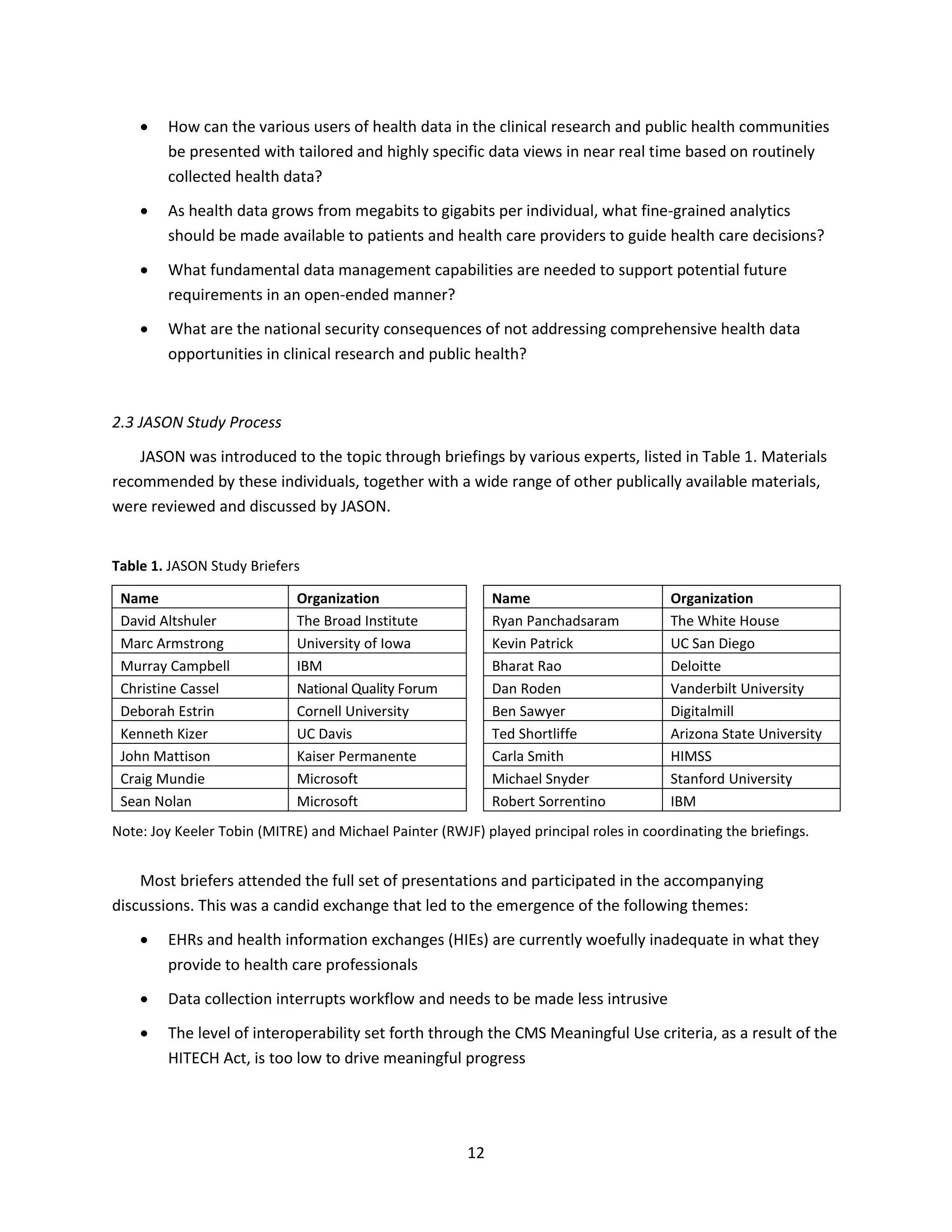
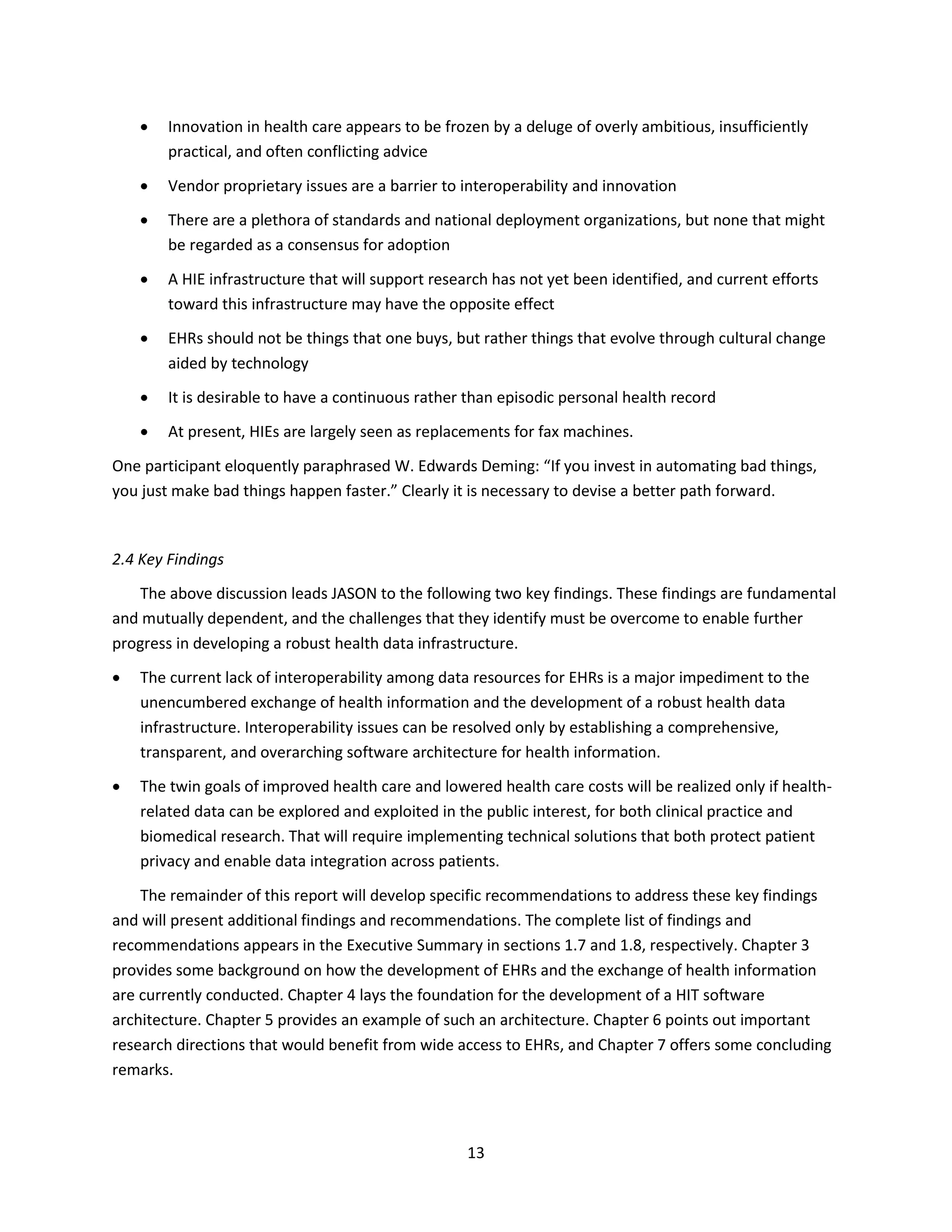
![14
3 Health Information Exchange Today
There is a growing consensus in the biomedical community, especially at the administrative level,
that the appropriate use of EHRs and HIEs could lead to improved health outcomes overall, and help to
lower health care costs in the long term. The movement towards EHRs (and their exchange via HIEs and
other mechanisms) enjoys support from many funding and regulatory agencies, health care providers,
health entrepreneurs, and other stakeholders within the biomedical community. Limited but seemingly
successful implementations of EHRs and HIEs already exist in selected cases, for example, at the VA,
Kaiser Permanente, Vanderbilt University Medical School, and in a few other countries.
Evidence that the widespread use of EHRs and HIEs actually improves the quality, safety, or
efficiency of health care in the US has been slow to accumulate. This lack of evidence is partly
attributable to slower-than-anticipated adoption rates of computerized HIT systems, especially among
small health care organizations and individual providers [2,3]. EHR adoption has been incentivized by
HITECH (Health Information Technology for Economic and Clinical Health), a program that was part of
the American Recovery and Reinvestment Act of 2009. That program has made more than $15.5 billion
available (through July 2013) to hospitals and health care professionals based on their meeting certain
EHR benchmarks for so-called “meaningful use.” This is one of the largest investments in health care
infrastructure ever made by the federal government.
The evidence for modest, but consistent, improvements in health care quality and safety is growing,
especially over the last few years [4]. Evidence has recently emerged to indicate that EHRs can indeed
reduce the costs of health care in the general community setting, and not just in an academic hospital
and its affiliated practices or in a large-scale health care enterprise. A recent study of 180,000
outpatients and 800 clinicians in communities that had adopted EHRs from multiple vendors found that,
over a multi-year period, the overall cost of outpatient care was reduced by 3.1% relative to the control
group [5]. These and other encouraging findings suggest the potential for improved efficiency program-
wide.
3.1 The Stakes are High and Complex
Even with the emerging evidence of benefit, implementing the useful exchange of EHRs across the
entirety of the US presents an enormous challenge. That challenge is made more difficult by the
multifactorial nature of the problem. Serious issues need to be faced at every level of implementation.
These issues do not fit neatly into a traditional classification scheme of technical, organizational,
sociocultural, and regulatory concerns. Rather, most of the issues and challenges cut across several of
those areas. The following list of problems gives a window into the complexity of implementing a
comprehensive and robust national heath data infrastructure.
1. The federation problem. There are at least 50 separate agencies charged with health care
responsibilities in the federal government. There are also the 50 states, each running its own health
care and public health systems. There are tens of thousands of private-sector health care providers](https://image.slidesharecdn.com/health-data-140720040559-phpapp02/75/A-Robust-Health-Data-Infrastructure-JASON-2013-17-2048.jpg)
![15
and enterprises, both large and small, delivering medical services. HHS might be regarded as the
closest approximation to a central authority for health care issues in the US government, but its
jurisdiction is limited.
2. The turf problem. Given the federation problem, different entities have assumed overlapping
jurisdiction for various aspects of health care delivery. Different federal agencies have authority over
different aspects of EHR implementation and exchange, but there does not appear to be any single
interagency group charged with coordinating and harmonizing these efforts. That said, two Federal
Advisory Committees have been created to assist with coordination: the Health IT Policy Committee
and the Health IT Standards Committee [9]. These advisory groups report to ONC, which has a broad
mandate for the coordination of HIEs. However, there has been lack of movement by these groups
since the release of the 2011 report by the President’s Council of Advisors on Science and
Technology (PCAST) on health information technology [10].
3. The scalability problem. A federated national database of all health-related information would be
enormous (on the order of exabytes). As the number of patient records grows, several “big data”
issues loom large, for example, pertaining to access, collation, storage, transport, maintenance, and
security of the data. The issues surrounding the management of vast amounts of data are being
addressed in many other research communities, and great strides are being made. Fortunately,
many of those solutions also could be applied to health-related data. The key to addressing the big
data issues surrounding improved health care and lower health care costs is the need for
interoperability among the data sources. This simply does not exist in current health care practice
and is impaired by the proprietary manner in which the data are curated.
4. The user interface problem. User issues are serious and threaten to scuttle the entire enterprise.
Data entry for EHRs is almost universally acknowledged to be cumbersome, offering no perceived
improvement over traditional handwritten charts. This is not merely an issue of training, but also a
serious workflow issue. The user interface is not up to modern standards and there is little incentive
to improve this situation. As a result of most current EHRs being part of a closed, vertically
integrated system, there is limited interoperability. The lack of competitive pressure gives little
opportunity for innovation that could result in better user interfaces.
5. The interdisciplinary problem. This problem is related to, but goes beyond, the user interface
problem. The EHR/HIE arena needs more players with interdisciplinary skills, particularly individuals
with training in both computer science and biomedicine. Such people do exist, but they are too few
in number at present. It will take some time for a new specialty discipline of biomedical information
technology to emerge and provide a substantial cohort of skilled workers. This issue is a common
theme across the many reports on modern health care from the US National Academy of Sciences
[11].
6. The front-loaded cost problem. The development and implementation costs for EHRs and HIEs are
acknowledged to be substantial. Who will pay for these costs? Up-front expenses are anticipated to
be more than offset by long-term health care savings. However, such savings may be realized](https://image.slidesharecdn.com/health-data-140720040559-phpapp02/75/A-Robust-Health-Data-Infrastructure-JASON-2013-18-2048.jpg)
![16
elsewhere in the health care economic system and won’t necessarily provide a good return on
investment to the entities directly responsible for implementing EHRs and HIEs. It has been
estimated that the implementation costs can exceed $32,000 per physician [12].
7. The payer problem. This problem is related to the front-loaded cost problem, but goes beyond it.
The ultimate payer for health care in the US is the individual consumer, but payment is carried out
through many intermediaries and indirect mechanisms, including via government taxation and
private health insurers. There is no clear answer as to which groups should bear the implementation
and maintenance costs for EHRs and HIEs. Some of this responsibility has been incentivized by
Meaningful Use funding provided through HITECH, but that seems insufficient and not sustainable
to drive the entire payment system.
8. The business model problem. There are several new business models for implementing limited
aspects of EHRs and HIEs, including Microsoft HealthVault [13] and BlueButton+ [14]. Importantly,
these all rely on external ways of collecting and entering data into EHRs, and so only address part of
the problem. None of these models have yet been established to be economically viable. The
decision in 2013 by Google to terminate Google Health [15] is an indicator that success is not
guaranteed. If any self-sustaining, private sector alternative to government-funded EHRs and HIEs is
to arise from the free market and exist stably, it must establish and prove a viable business model.
For such a model to survive, it needs an innovation boost. That will require breaking down the
barriers of closed proprietary systems that are highly limited in their interoperability. It will require
publishing interfaces and protocols, built around an agreed-upon software architecture that will
provide the basis on which new business models can develop and evolve.
9. The exchange concept problem. Widely different concepts currently exist among health care
professionals regarding what a HIE can and should do. These concepts differ as to what types of data
the HIE should manage, as well as who should have access to the data and for what purposes.
10. The data security problem. Individual health data are almost universally considered to be sensitive
and in need of protection. Beyond privacy concerns, which are considerable, the safeguarding of
individual health care information is vital to protect against fraud, identity theft, and other types of
criminal abuse. If protection and security are not part of the systems that are developed, people will
not trust the technology and will not participate in it. Conversely, population health data are
considered to be extremely valuable assets for clinical practice and biomedical research, and
therefore very much in the public interest to be exploited. The Health Insurance Portability and
Accountability Act of 1996 (HIPAA) [16] enacted complex privacy provisions for health care records,
with stiff penalties for violation, enforced by HHS. Some regulatory aspects of HIPAA are
controversial, and some others are viewed as an impediment to biomedical research. Regardless,
there are many difficult security issues associated with keeping individual data secure while moving
forward with population studies in the public interest.
11. The data integrity problem. There are many issues pertaining to the accuracy and consistency of the
data, including the need for highly reliable disambiguation of an individual’s health information. The](https://image.slidesharecdn.com/health-data-140720040559-phpapp02/75/A-Robust-Health-Data-Infrastructure-JASON-2013-19-2048.jpg)
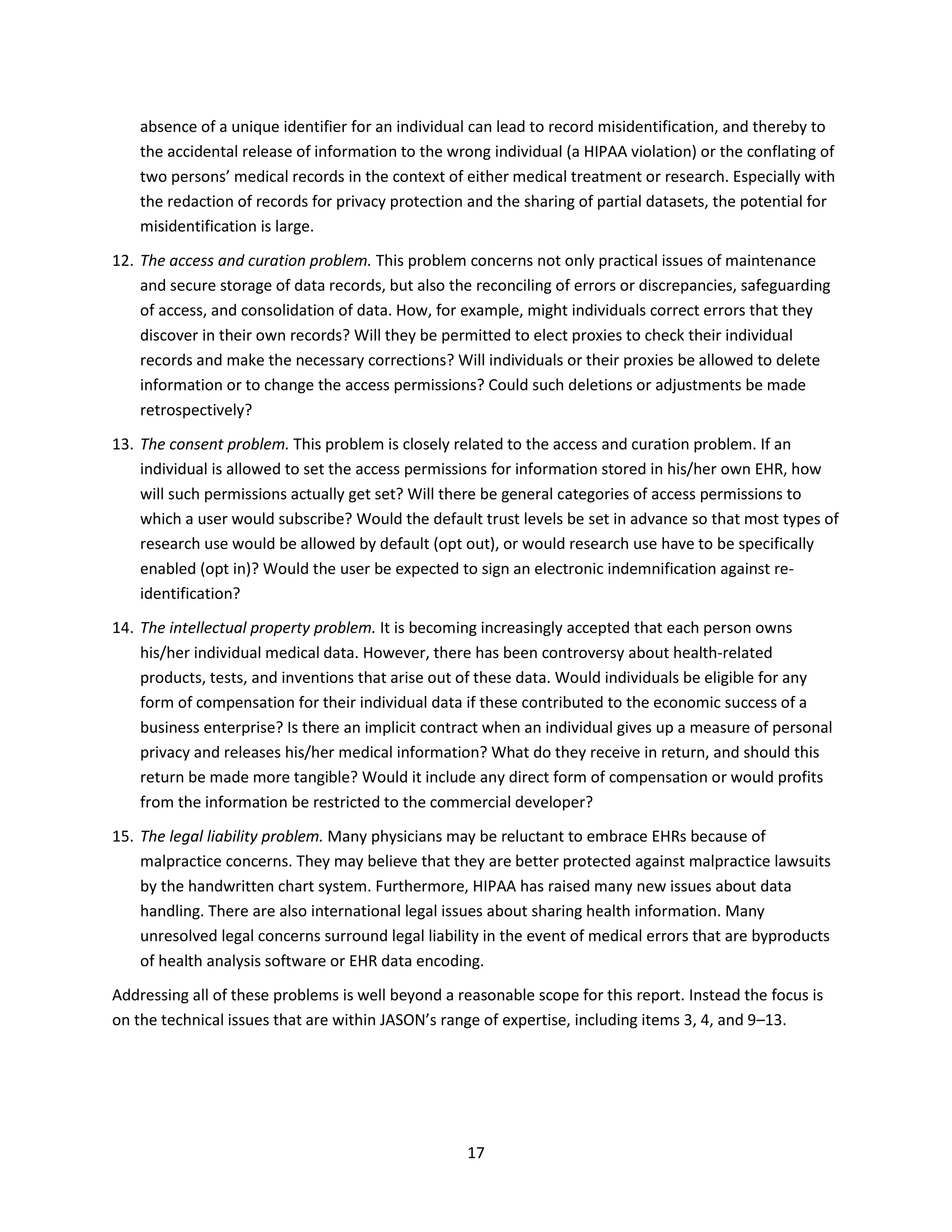
![18
3.2 HITECH and Meaningful Use
The HITECH Act, enacted in 2009, aimed to accelerate the development and adoption of EHRs and to
synergize the creation of a robust, sustainable, HIT infrastructure in the US. HITECH included
commitment to significant financial incentives and investment ($27 billion over 10 years) by the US
government to health care providers and to the states for demonstratively improving health care
delivery, quality, and outcomes. The targeted health care providers include physicians, nurse
practitioners, certified nurse midwives, dentists, physician assistants, acute care hospitals, and children’s
hospitals. With the exception of the hospitals and pediatricians, eligible health care providers must have
a 30% minimum volume of Medicaid patients.
The incentive program is based on health care providers meeting the CMS Meaningful Use criteria,
that is, meaningfully using federally certified EHR technology. There are three stages to the incentive
program, and failure to participate will result in financial disincentives in the future. Stage 1 will be
completed in 2013, Stage 2 has been defined and will commence in 2014, and Stage 3 has not yet been
defined. Table 2 summarizes the Stage 1 objectives. Stage 2 requires increased level of implementation
for most of the Stage 1 criteria; eliminates a few objectives, such as providing patients timely electronic
access to their health information; and adds a requirement of secure electronic messaging to at least 5%
of the patients. CMS maintains a complete description of Meaningful Use and current information on
the incentive program [17].
The following finding and recommendation summarizes JASON’s assessment of the current situation
regarding the adoption of EHRs.
Finding
The criteria for Stage 1 and Stage 2 Meaningful Use, while surpassing the 2013 goals set forth by
HHS for EHR adoption, fall short of achieving meaningful use in any practical sense. At present,
large-scale interoperability amounts to little more than replacing fax machines with the electronic
delivery of page-formatted medical records. Most patients still cannot gain electronic access to their
health information. Rational access to EHRs for clinical care and biomedical research does not exist
outside the boundaries of individual organizations.
Recommendation
CMS should embrace Stage 3 Meaningful Use as an opportunity to break free from the status quo
and embark upon the creation of a truly interoperable health data infrastructure.](https://image.slidesharecdn.com/health-data-140720040559-phpapp02/75/A-Robust-Health-Data-Infrastructure-JASON-2013-21-2048.jpg)
![19
Table 2. Summary of Core Objectives for Stage 1 Meaningful Use
Objective Measure
Record patient demographics (sex, race, ethnicity,
date of birth, preferred language, and in the case of
hospitals, date and preliminary cause of death)
Over 50% of patients’ demographic data recorded as
structured data
Record vital signs and chart changes (height, weight,
blood pressure, body-mass index, growth charts for
children)
Over 50% of patients 2 years of age or older have
height, weight, and blood pressure recorded as
structured data
Maintain up-to-date problem list of current and
active diagnoses
Over 80% of patients have at least one entry
recorded as structured data
Maintain active medication list Over 80% of patients have at least one entry
recorded as structured data
Maintain active medication allergy list Over 80% of patients have at least one entry
recorded as structured data
Record smoking status for patients 13 years of age or
older
Over 50% of patients 13 years of age or older have
smoking status recorded as structured data
For individual professionals, provide patients with
clinical summaries for each office visit; for hospitals,
provide an electronic copy of hospital discharge
instructions on request
Clinical summaries provided to patients for >50% of
all office visits within 3 business days; >50% of all
patients discharged from the inpatient or emergency
department of an eligible hospital or critical access
hospital and who request an electronic copy of their
discharge instructions are provided with it
On request, provide patients with an electronic copy
of their health information (including diagnostic-test
results, problem list, medication lists, medication
allergies, and for hospitals, discharge summary and
procedures)
Over 50% of requesting patients receive electronic
copy within 3 business days
Generate and transmit permissible prescriptions
electronically (does not apply to hospitals)
Over 40% are transmitted electronically using
certified EHR technology
Computer provider order entry (CPOE) for
medication orders
Over 30% of patients with at least one medication in
their medication list have at least one medication
ordered through CPOE
Implement drug–drug and drug–allergy interaction
checks
Functionality is enabled for these checks for the
entire reporting period
Implement capability to electronically exchange key
clinical information among providers and patient-
authorized entities
Perform at least one test of EHR’s capacity to
electronically exchange information
Implement one clinical decision support rule and
ability to track compliance with the rule
One clinical decision support rule implemented
Implement systems to protect privacy and security
of patient data in the EHR
Conduct or review a security risk analysis, implement
security updates as necessary, and correct identified
security deficiencies
Report clinical quality measures to CMS or states For 2011, provide aggregate numerator and
denominator through attestation; for 2012,
electronically submit measures
Reproduced from Blumenthal and Tanner [1].](https://image.slidesharecdn.com/health-data-140720040559-phpapp02/75/A-Robust-Health-Data-Infrastructure-JASON-2013-22-2048.jpg)
![20
3.3 Health Information Exchange (HIE) versus the Exchange of Health Information
In addition to providing financial incentives for meaningful use, the HITECH Act provides financing
for grants through the ONC for the creation of statewide HIEs. These are organizations that oversee and
loosely govern the exchange of electronic health information. There are now more than 200 of these
organizations, 22 in California alone. These organizations act as consolidation points for health records,
with the goal of reducing the high costs of information flow by using electronic means. HIEs may be run
by state agencies or privately, and are subject to numerous state and federal regulations, some which
are still being defined.
A sustainable business model for HIEs remains to be established [18,19]. A recent report [20] found
that 74% of the HIEs surveyed have issues of financial viability, reporting that the development of a
sustainable business model is a moderate or substantial barrier. The various HIEs use disparate and
largely incompatible technical approaches (e.g., query models, push models, end-to-end interrogation).
Only 30% of hospitals currently receive data from HIEs, and only 10% of ambulatory practices do so.
In contrast, the exchange of health information refers more generally to the mobilization of health
care information in electronic form, including the contents of EHRs, within or across organizations. This
exchange may, or may not, be carried out through a HIE. The remainder of this report will focus on the
exchange of health information in the general sense, rather than HIEs per se.
A meaningful exchange of information, electronic or otherwise, can take place between two parties
only when the data are expressed in a mutually comprehensible format and include the information that
both parties deem important. While these requirements are obvious, they have been major obstacles to
the practical exchange of health information.
With respect to data formats, the current lack of interoperability among the data resources for EHRs
is a major impediment to the effective exchange of health information. These interoperability issues
need to be solved going forward, or else the entire health data infrastructure will be crippled. One route
to an interoperable solution is via the adoption of a common mark-up language for storing electronic
health records, and this is already being undertaken by ONC and other groups. However, simply moving
to a common mark-up language will not suffice. It is equally necessary that there be published
application program interfaces (APIs) that allow third-party programmers (and hence, users) to bridge
from existing systems to a future software ecosystem that will be built on top of the stored data. The
issues of data formats and interoperability will be discussed in more detail in the next two chapters.
With respect to the value of the information, there is a natural tension between the private and
public use of health-related data. Individual patient health data are sensitive and therefore must be
carefully safeguarded, whereas population health data are a highly valuable, and largely untapped,
resource for clinical practice and basic research. It is in the public interest to make such information
available for scientific, medical, and economic purposes, thereby helping to realize the promise of a
robust health data infrastructure. Any HIT system for health care must attempt to balance these
countervailing demands. The research value of EHRs and the consequences associated with
implementing data redaction as an approach to safeguarding privacy will be discussed in Chapter 6.](https://image.slidesharecdn.com/health-data-140720040559-phpapp02/75/A-Robust-Health-Data-Infrastructure-JASON-2013-23-2048.jpg)
![21
3.4 Lessons Learned from Abroad
There is a tendency to look abroad and believe that solutions to the nation’s most difficult HIT
problems may be found there. This “grass is greener” mentality ignores the difficulties that have
occurred with the development of other health data infrastructures, and limits the benefit of lessons
that can be learned from abroad. It is important to look at the failures as well as the successes, and to
take into account the different social and political realities when seeking guidance from the experience
of other countries.
This section highlights international lessons learned that have informed JASON’s thinking. It is not
intended to provide a complete international perspective on HIT, which has been the subject of many
papers and monographs [21.22]. Rather, the focus is on the lessons most relevant to this study. The core
lessons include the following.
Do not underestimate the importance or challenge of security and privacy.
What works at a provider or regional level will not necessarily scale well to a national level.
The ability to carry out search and indexing of EHRs holds substantial promise for improving
public health outcomes and should be a core component of the software architecture for HIT.
3.4.1 Sweden
The Swedish Ministry of Health and Social Affairs sets the agenda and provides principles and
guidelines for the Swedish health care system. The actual implementation of the health care system is
through 21 county councils, which have the power of taxation and operate independently. As a result,
there are several different electronic health information systems in Sweden, represented by five
different vendors. The 21 independent health care systems have coevolved over decades. The services
they provide are comparable, but the systems differ significantly across regions. For example, although
Sweden has had EHRs for several decades, the records could not be exchanged across regions until
recently, due to differing capabilities.
In 2008 Sweden launched an initiative for the development of a national EHR that would provide
electronic access to health records for patients, health care professionals, and health care facilities in
the nation. A key issue to moving forward with this initiative was to address privacy and security in a
transparent manner based on unique identifiers. Sweden implemented a national authentication service
and a common e-prescription service, which has the highest utilization level of any country. It is
encouraging that in just five years since the initiative was launched, Sweden has created a system with
100% electronic health records and nearly 90% electronic prescriptions.
In late 2010 Sweden launched a national on-line medical records system for access by patients and
health care professionals. In just a few years, this has enabled patients and their health care providers to
access health records at home and while traveling in other parts of Sweden. Sweden also has a common](https://image.slidesharecdn.com/health-data-140720040559-phpapp02/75/A-Robust-Health-Data-Infrastructure-JASON-2013-24-2048.jpg)
![22
Picture Archiving Communications System (PACS) for radiology. In order to exchange health information
between health organizations, a patient must first give consent. Five major vendors supply EHR
technology and three major vendors provide PACS technology in Sweden.
The situation in the US is significantly more complex than in Sweden. In the US there is no unique
identifier for each patient, and the US system of both private insurers and public insurance (Medicare
and Medicaid) provides many more payment models and incentives compared to the situation in
Sweden. However, one can draw lessons regarding HIT expectations from the Swedish experience. First,
it takes years, if not decades, to grow a functioning health data infrastructure from the seeds of EHRs,
but once there is sufficient buy-in and cooperation, then progress can be rapid. One of the largest
challenges is coping with legacy systems and work processes. A second lesson is not to underestimate
the need for early design of security and privacy measures, beginning at the concept phase of a HIT
system. Sweden saw late-stage delays because of a lack of effective security controls. It will be much less
expensive and more effective in the long run to build upon deeply integrated security and privacy
measures from the start.
3.4.2 United Kingdom
The National Health Service (NHS) in the UK is often used as the exemplar of a single-payer health
care system. Operational since 1948, it enjoys widespread support among the population, although in
terms of health outcomes it is ranked 15th in Europe and 18th worldwide. The NHS is a confederation of
four national health systems (England, Scotland, Wales, and Northern Ireland). All residents of the UK
are entitled to health care under these four systems. Despite the unifying role of the government, there
is significant variation in the quality of care across regions, including with regard to the ability to
exchange electronic health information.
There are several lessons to learn from the successes and failures of the NHS and the exchange of
health information in the UK. First, one should not underestimate the threat posed by insiders regarding
the risk of health information disclosure. Second, one should be skeptical of claims of security when no
mechanism exists for independent validation and verification.
The NHS has suffered several embarrassing security and privacy violations that stem from its lack of
capability to control access to databases. In 2009 a staff member compromised the medical records of
then Prime Minister Gordon Brown via insider access [23,24]. This happened despite assurances from
the NHS that data were protected using the “highest standards of security.” Unfortunately, such
vacuous claims of security are all too common. Security only comes through careful engineering and
constant vigilance and refinement. The trusted computing base of the NHS is too large to prevent
authorized individuals from inappropriately disclosing health information. As has been pointed out [25],
a national system “holding 50,000,000 records is too big a target, will be cumbersome, fragile, and
unsafe, and failures to properly protect privacy will have real costs in safety and access — particularly
for the most vulnerable or at risk sections of societies.” While an audit-based access control may suffice](https://image.slidesharecdn.com/health-data-140720040559-phpapp02/75/A-Robust-Health-Data-Infrastructure-JASON-2013-25-2048.jpg)
![23
within a single clinic or hospital, the same processes will fail to provide adequate privacy protection at a
national level.
A second key lesson is to be skeptical of vendor claims about security and privacy without proof that
can be independently validated and verified in an irrefutable manner. One should be especially dubious
of claims that encryption “solves” a security problem because poorly used encryption is virtually
indistinguishable from properly used encryption. Both poor and proper use of encryption employ the
“highest standards of security.” Many poorly engineered systems employ encryption, but were designed
by people with little or no data security expertise, including smart meters, automobiles, and SCADA
systems. These systems are deployed and fill important roles, but are highly vulnerable to attack due to
poorly designed security. The security of EHRs cannot be left to the vendors of HIT systems, and must
instead be part of an encompassing, robust health data infrastructure.
3.4.3 Taiwan
Taiwan implemented a national HIE that is tightly coupled with smartcards carried by individual
patients. These smartcards serve to ferry compact EHRs, with remarkable success. They also serve to
authenticate the individual to deter fraud, with mixed success. Taiwan has approximately 500 hospitals
and 20,000 clinics [26]. Only about half of the hospitals participate in the Taiwanese HIE, a system that
has been in place since 2009. Under strict privacy controls, cleared personnel can access medical records
from a central database to identify urgent public health trends, such as the SARS outbreak.
One lesson to draw is that the US health data infrastructure should not eliminate the possibility of
smartcards or their equivalent, patient-controlled cloud storage, or some other future technology from
being used in conjunction with traditional storage for medical data. A second lesson is the value of a
rapid search and indexing capability to support public health.
3.5 Veterans Administration and Department of Defense
The VA and DOD operate two of the largest health care systems in the world. They have
independently developed EHR systems and for more than 15 years they have made failed attempts to
achieve some level of interoperability between their systems. The two systems are described briefly
here, especially with regard to their current state of interoperability.
3.5.1 VA VistA System
The VA VistA system is widely regarded as one of the best electronic medical information systems in
existence. This HIT transformation of the VA health care system is often cited as the largest and most
successful health care turnaround in US history [27]. Whereas the development of VistA started before
1985 (initially called the Decentralized Hospital Computer Program, DHCP), the actual transformation
began in 1995, and by 1999 the VA was able to:](https://image.slidesharecdn.com/health-data-140720040559-phpapp02/75/A-Robust-Health-Data-Infrastructure-JASON-2013-26-2048.jpg)
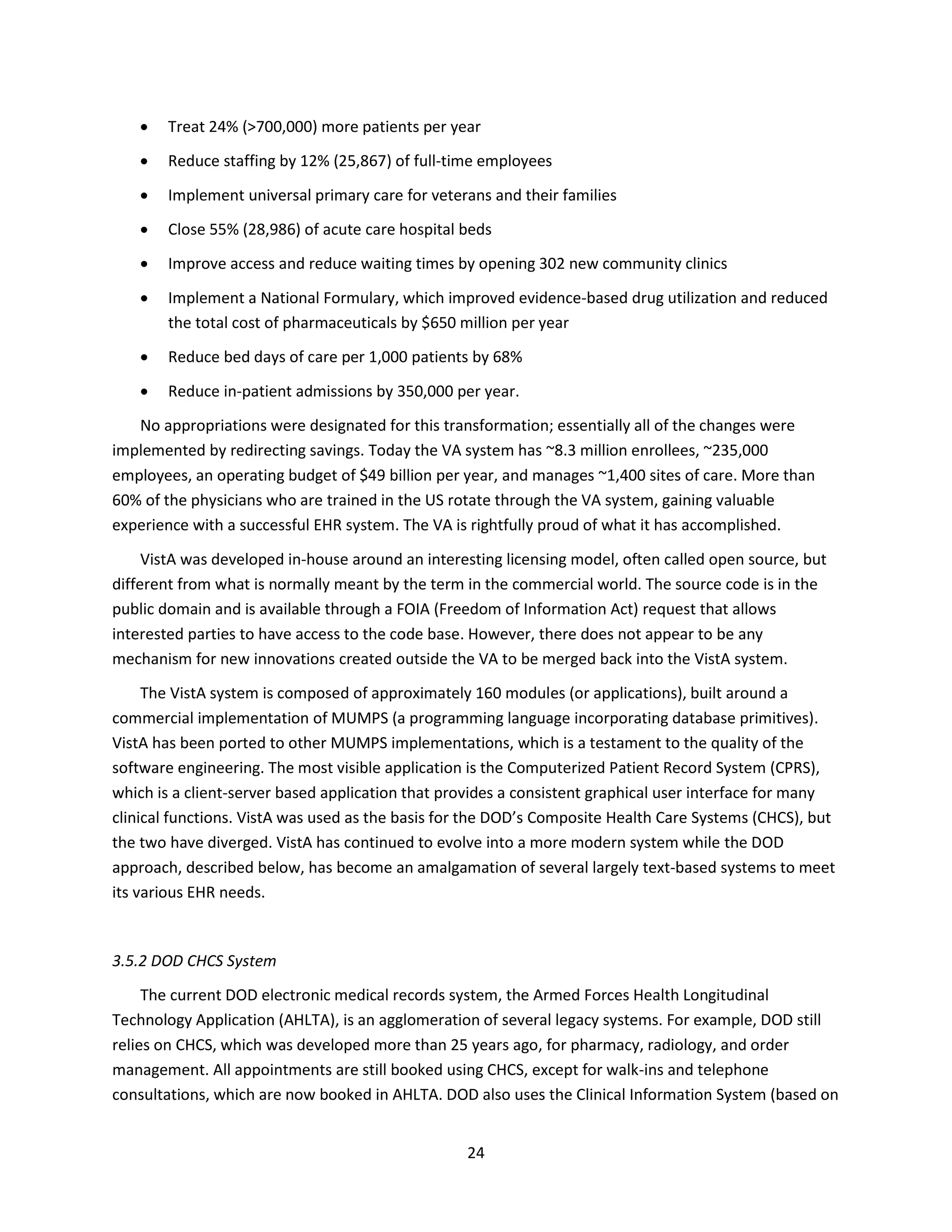
![25
Essentris, a commercial product), which has been customized to support inpatient treatment at military
medical facilities.
AHLTA is the clinical document engine used by physicians for orders, notes, and other
documentation. It is also used as the basis for medical coding. It uses CHCS and its various modules to
store this information via the Comprehensive Ambulatory Patient Encounter Record (CAPER) interface.
CHCS was developed under contract by SAIC in 1988 for $1.02 billion. It uses the original code base of
the VistA system. As a result, it too is module-based and built around a MUMPS engine. Despite their
common code legacy, the two systems are not compatible. While VistA has been modernized, CHCS
remains a text-based system that requires the computer to emulate a DEC VT320, a terminal that has
not been manufactured for almost 20 years.
3.5.3 VA and DOD Interoperability
In 2008 the VA and DOD were directed through the National Defense Authorization Act to jointly
develop some interoperable EHR capability. This failed and in 2009 the two entities created the Virtual
Lifetime Electronic Record initiative (VLER) [28]. Conceptually, VLER looks and sounds promising, but has
yet to be fully implemented. In 2010, and again in 2011, joint initiatives to achieve some level of EHR
interoperability between the VA and DOD were initiated. These efforts were to continue through 2017.
However, after this long and expensive attempt to meet the Congressional mandate of interoperability,
the VA and DOD recently announced that they would no longer pursue a single integrated electronic
medical information system [29–31]. The GAO cited cost and management problems, and indeed these
were formidable. The cost rose from an already astounding $4 billion to an estimated $12 billion before
the project was abandoned. The VA stated that it would cost $16 billion to replace its current VistA
system.
In May 2013 Secretary Hagel, following a 30-day review, decided that the DOD would seek a
commercial solution [32]. DOD has pledged that the commercial solution it adopts will be compatible
with and be able to exchange medical information with VistA, as well as other major commercial
electronic medical information systems. It may turn out, and is perhaps likely, that the system the DOD
adopts will be a commercial derivative of VistA. Whereas seeking a commercial solution seems like a
sensible forward path, there are hazards that DOD should be aware of. Chief among these is treating this
as a fixed procurement process and not taking into account the rapid evolution of technology and the
changes that a robust health data infrastructure will bring to clinical practice and the delivery of health
care. Both the VA and DOD should take this opportunity to agree upon a set of interfaces and data
formats that will allow them to exchange information freely. Chapter 6 will address this point more
specifically and provide a recommendation for a new path forward for the VA and DOD.](https://image.slidesharecdn.com/health-data-140720040559-phpapp02/75/A-Robust-Health-Data-Infrastructure-JASON-2013-28-2048.jpg)
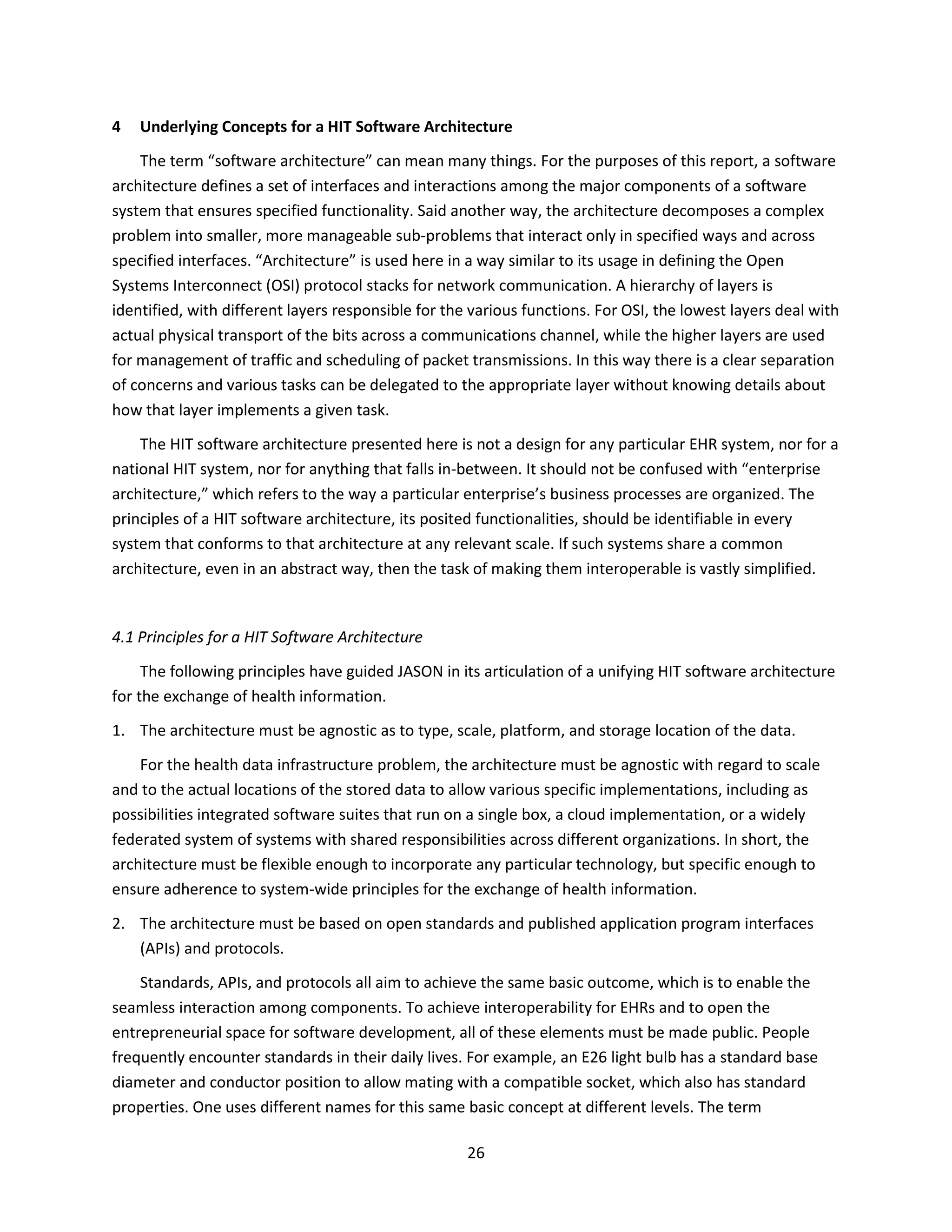
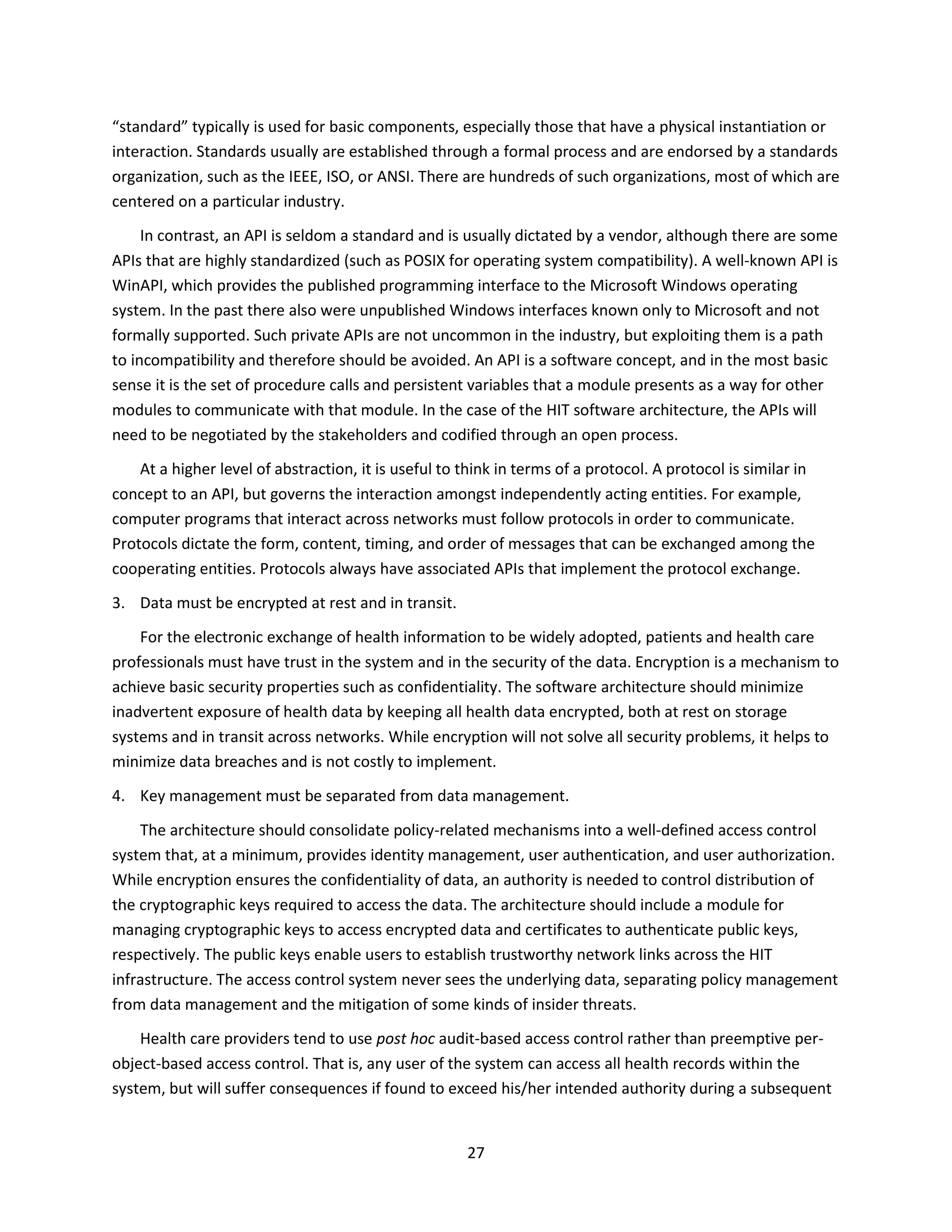
![security audit. The exchange of health information at the national level is too large to manage using an
audit-based model. Instead, the software architecture must provide an integrated mechanism for
cryptographic key management that is separate from management of the data.
5. Data must be accompanied by relevant metadata and provenance information.
Provenance refers to the chain of custody of the data, from its inception and through its entire
history of access, transmission, or modification. Having knowledge of what the data are and where they
came from gives context when interpreting the data for either clinical care or biomedical research. One
of the lessons learned from past standardization of medical imaging is that metadata and provenance
are important to capture along with the primary data. The DICOM (Digital Imaging and Communications
in Medicine) standard for radiological imaging, established in the early 1980s, performs well with
exchanging pixels. However, the early designers of that standard did not anticipate the specificity and
tremendous quantity of data that would ensue. As a result, DICOM fumbled with regard to metadata,
such as procedural and patient-specific information. Users of DICOM systems still have difficulty today
distinguishing whether a particular image came from an echocardiogram or coronary ultrasound
because of the lack of metadata.
6. EHRs should be represented as a collection of atomic data items and associated metadata.
A software architecture that can represent the individual elements in an EHR (e.g., blood pressure
measurement, serum glucose level), together with the associated metadata, will provide maximum
flexibility in data handling and security. The atomic data elements can be reassembled in various ways
for either clinical or research purposes, and distinct user permissions can be associated with each data
element.
7. The robustness principle should be followed: be liberal in what you accept and conservative in what
you send.
Because the software architecture will contain many interacting components, developed by multiple
vendors and used in various contexts, interoperability is a key concern. As a guide to how broad
interoperability can be achieved, one should look to the Internet communications protocols. In
developing robust communication among the various layers, Internet protocols observe Postel’s Law,
first articulated in RFC 760 [33]: “An implementation should be conservative in its sending behavior, and
liberal in its receiving behavior.” This approach has served Internet communications extremely well, and
was restated as the “robustness principle” in RFC 1122 [34], which defines the lower layers of the
Internet protocols.
For the HIT software architecture to follow the principle of robustness means that implementations
of the data formats, APIs, protocols, and other elements of the system should make every effort to
adhere to the agreed-upon specification. At the same time, developers of these implementations should
realize that the developers of other components of the system might deviate from the specification, by
either mistake or design. By being tolerant of these imperfections, small deviations of little consequence](https://image.slidesharecdn.com/health-data-140720040559-phpapp02/75/A-Robust-Health-Data-Infrastructure-JASON-2013-31-2048.jpg)
![29
do not bring the system to a halt. For example, if a vendor adds additional fields to the metadata of a
laboratory test result, that should not cause the data to be rejected.
Another lesson from the computer networking community regarding interoperability is the value of
conducting a “connect-a-thon” or “bake-off” to test whether disparate components can operate
together seamlessly to form the network. These hands-on events bring together the vendors, who must
demonstrate that their particular component can connect and interoperate correctly with those
provided by other vendors. Current EHR systems do not interoperate at all, and in many cases are
unable to even exchange data between hospitals running the same system from the same vendor.
Moving forward will require HIT vendors to demonstrate that they can meaningfully exchange
information in a seamless fashion.
8. A migration pathway must be provided for legacy EHR systems.
Today’s EHR systems are already legacy systems, many of which are built on the MUMPS database
technology first developed in the 1960s [35]. Unfortunately, these systems are likely to dominate the
HIT landscape for years to come. The development of a unifying HIT software architecture needs to
move aggressively forward in light of this reality. There must be an opportunity for the legacy systems to
operate within a new and evolving software architecture. This can be accomplished through public APIs
that provide portals between the legacy systems and the modern architecture. These APIs would allow
the new architecture to be populated from the legacy systems until the time when all data and
functionality are fully contained within systems embodying the new architecture. For example, search
functions could pull data from the legacy systems and index those data so that they are more amenable
to general queries. User interface applications could capture formatted screen shots from the legacy
systems and reformat the information to better meet the needs of individual users. In this way, the
interoperability of the new system would begin to take shape even before all of the data reside within
the architecture.
4.2 Focusing on the Patient
The software architecture that JASON proposes adopts the principle that the ultimate owner of a
given health care record is the patient him/herself. Before discussing the practical aspects of this
position, it should be noted that focusing on the patient draws upon a higher principle to which all
health care professionals subscribe: it is not merely to “do no harm” [36], but to do one’s best for the
patient. Despite cynicism about the US health care system, the 878,000 licensed physicians [37], 2.8
million registered nurses [38], and nearly 10 million other medical professionals are focused primarily on
caring for their patients. When faced with decisions about how to implement systems for exchanging
health information, one should ask: “What is best for the patient?” The answer usually provides clarity
to help cut through the debate about these matters.
The patient knows who he/she is, which facilitates accurate identification and disambiguation of
conflicting identifiers. The patient also knows whom he/she trusts, which forms the basis for granting](https://image.slidesharecdn.com/health-data-140720040559-phpapp02/75/A-Robust-Health-Data-Infrastructure-JASON-2013-32-2048.jpg)
![30
authorization to access health information. The Health Insurance Portability and Accountability Act of
1996 (HIPAA) includes a Privacy Rule that prevents the disclosure of protected health information
without written authorization from the patient, other than to facilitate treatment, payment, or health
care operations [16]. Reasonable effort must be made to minimize such disclosures and the patient
must be notified of any use of his/her health information. These protections can be met through
electronic authorization services, that apply to both the data and accompanying metadata.
The patient is aware of his/her own medical condition. The standard doctor visit includes a ritualized
account of the patient’s chief complaint (reason for the visit), history of present illness, medications,
medical history (e.g., allergies, immunizations, major illnesses, surgeries), review of systems (checklist of
positive and negative symptoms), social history, and family history. Typically this ritual is repeated many
times, generating redundant and sometimes conflicting information that is dutifully logged in separate
physical or electronic records. If instead this information were to travel virtually with the patient,
continually updated and cross-checked, the patient’s awareness of his/her medical condition would be
enhanced.
Patients who are minors or are physically or mentally incapacitated may be unable to fulfill the
responsibility of managing their electronic health information. There are legal provisions that allow a
parent or legal guardian to act on behalf of these patients in accessing their health information. The
parent or guardian has the authority and the duty to act in the patient’s best interests. There also are
circumstances where other entities require access to portions of the patient’s health data, for example,
for public health reporting of cancers and communicable diseases, in meeting law enforcement
requirements, and as part of the implied consent that occurs when a patient accepts treatment or
hospitalization. Thus a health data infrastructure that is focused on the patient still allows other parties
to gain access to the data as necessary.
A likely benefit of empowering the patient as the ultimate owner of his/her electronic health
information is that it places increased responsibility on the patient for health maintenance. The patient
will have responsibility for becoming educated and staying informed about his/her condition and for
making good lifestyle choices. He/she will play an active role in data gathering through web-based
reporting, wireless sensors, and other electronic communications. He/she will be expected to engage in
preventative care and seek early intervention for adverse conditions. Finally, the patient will have
responsibility for complying with medical treatment, including prescribed medications, physical therapy,
and follow-up care. Historically the patient was a passive recipient of medical treatment, although this
situation has changed somewhat over the past few decades with increasing emphasis on informed
consumerism. Now there is the opportunity for patients to become more thoroughly engaged, and
enlightened, about their own medical care as EHRs transform to PHRs (personal health records) [39].
Health care professionals, in support of what is best for their patients, will want their patients to
become active partners in achieving good health.](https://image.slidesharecdn.com/health-data-140720040559-phpapp02/75/A-Robust-Health-Data-Infrastructure-JASON-2013-33-2048.jpg)
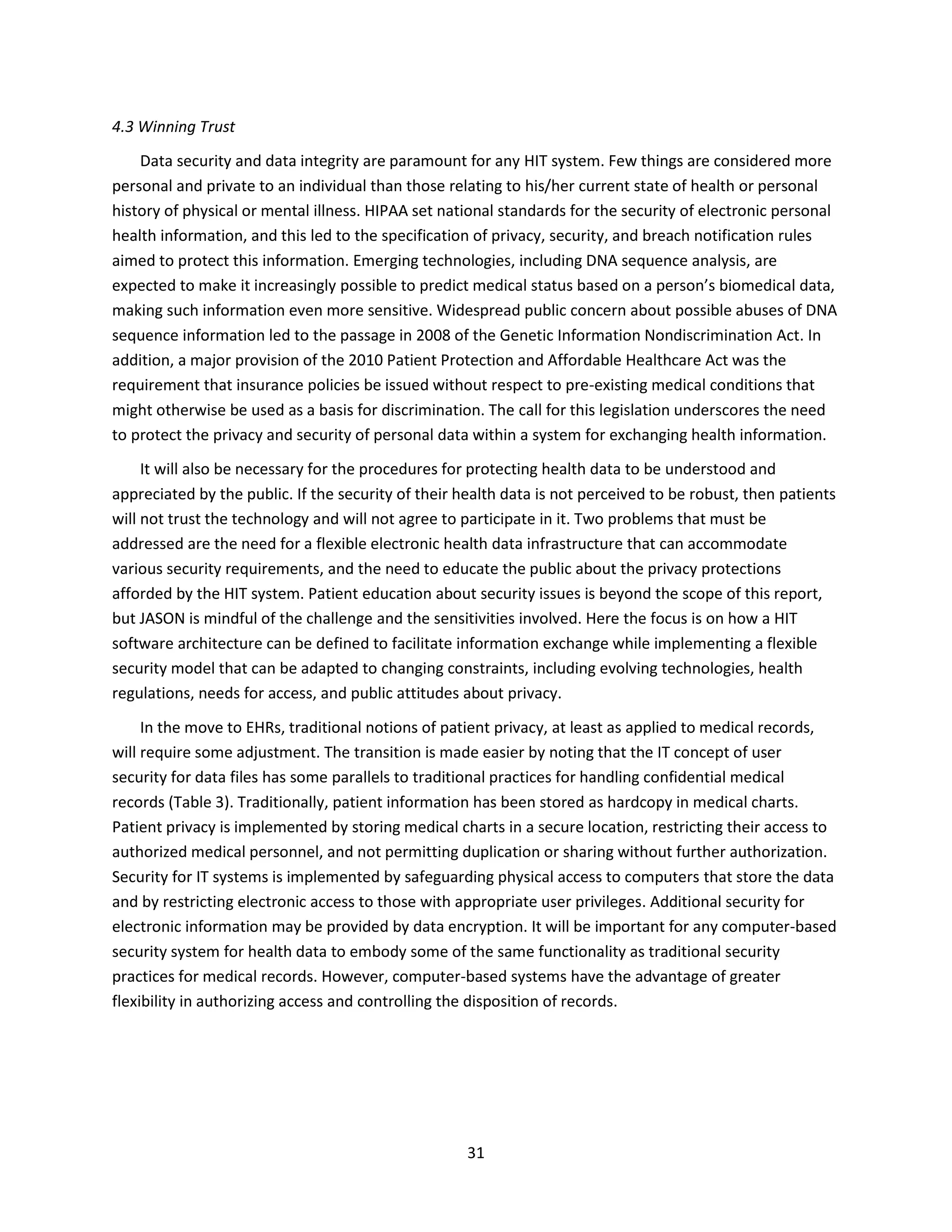
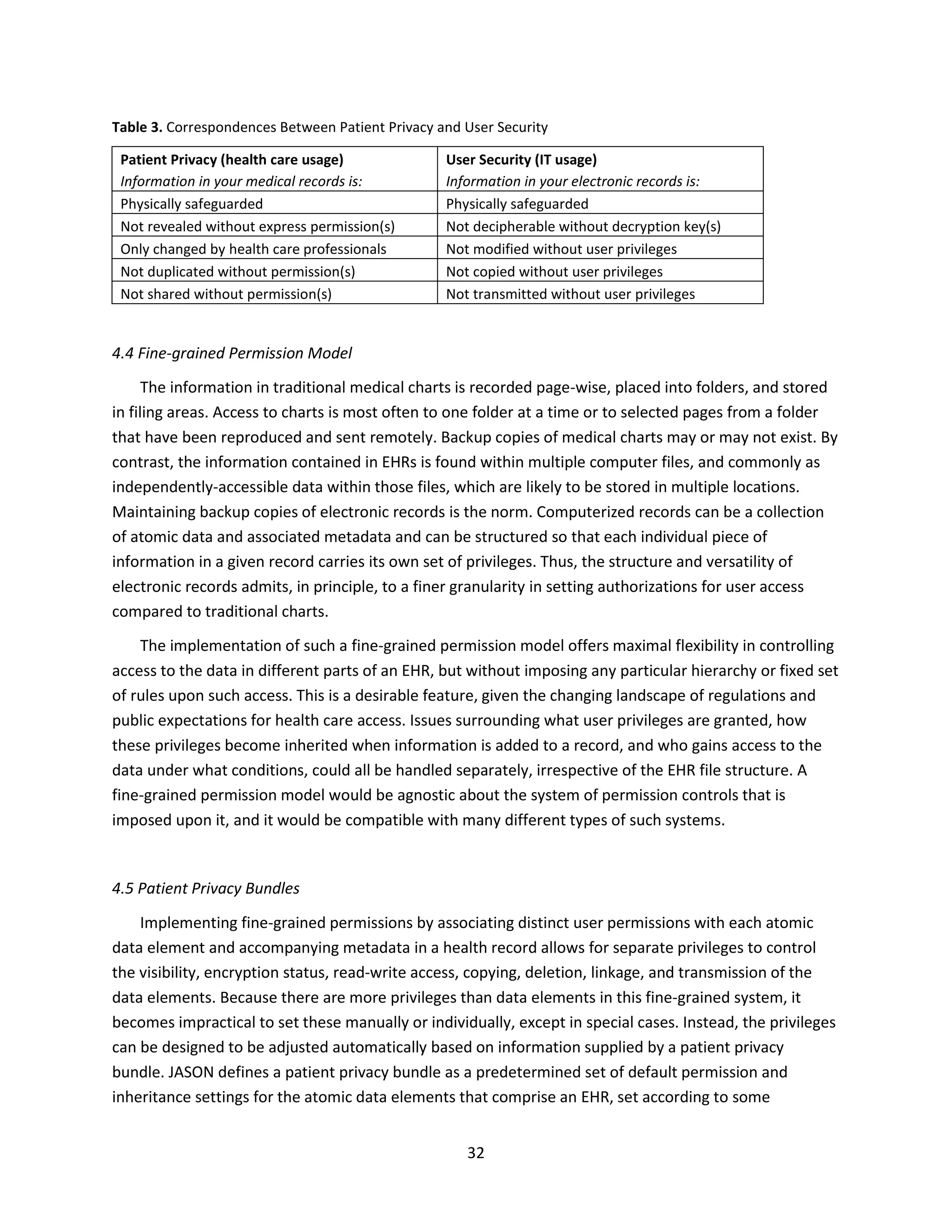
![33
predefined security policy. The election of a given privacy bundle and the corresponding choice of policy
governing data access would reside with the patient, to be chosen in consultation with his/her health
advisors and health care providers. This security model encapsulates the notion that the patient
ultimately owns his/her own data. It is anticipated that different patients would opt for different levels
of assumed risk associated with sharing their personal data, in return for different perceived benefits
that may accrue from that sharing, both for themselves and for society.
Patient privacy bundles can be flexible because they enable the patient to share information
selectively. They represent, in effect, the personal security policy for an individual. For example, patient
privacy bundles may be set up to restrict access to certain types of information to designated individuals
or groups only (e.g., mental health records, family history, history of drug abuse) while making other
types of information more generally available to medical personnel (e.g., known allergies, vaccination
records, surgical history). In addition, patient privacy bundles represent a practical way to reveal
selectively to insurers or US government agencies only those data that may be required by law under
the current regulatory regime, such as reportable diseases and conditions. Patient privacy bundles also
afford the opportunity for an individual to elect to make some, or all, of his/her health data available for
biomedical research. In this regard, JASON strongly favors the creation and implementation of patient
privacy bundles whereby safeguarded data sharing for research purposes is permitted by default (an
opt-out system). Genomic research programs presently being carried out at major research hospitals
with opt-out policies for sharing DNA sequence information (e.g., Vanderbilt University Medical Center)
have achieved impressively high levels of patient participation [40].
Where will the patient privacy bundles come from? In practice, few patients would ever deal with
setting permissions for their own health data at the level of individual data elements. Instead, after
consultation with their health advisors and health care providers, they would elect to take a pre-
packaged patient privacy bundle designed and recommended to them by trusted parties. Examples of
such trusted parties include health care providers, health insurance providers, governmental advisory
bodies, medical advisory bodies, patient advocacy groups, and consumer advocacy groups — whomever
the patient, in his/her sole discretion, elects to trust as advisor.
In keeping with the principle that the patient owns his/her data, JASON envisages that patient
privacy bundles would enable health IT users to set the majority of access permissions to their own
EHRs. Nevertheless, any valid set of permissions will clearly need to comply with applicable federal and
state regulations regarding access to certain types of personal health information. For example, access
would be required by state public health systems and the National Notifiable Diseases Surveillance
System to information about reportable communicable diseases, foodborne and waterborne disease
outbreaks, pesticide-related illness and injury, cancer incidence, and lead exposure. Thus certain privacy
settings could be overridden, based on legal authority, by an authorized agency. In addition, for minor
children and others who require a legal guardian, the obligation for setting patient privacy bundles
would fall to the guardian or other responsible individual.
The extent to which patients will be willing to share their personal health information under a future
health data infrastructure remains to be seen. The situation is similar to other issues regarding sharing](https://image.slidesharecdn.com/health-data-140720040559-phpapp02/75/A-Robust-Health-Data-Infrastructure-JASON-2013-36-2048.jpg)

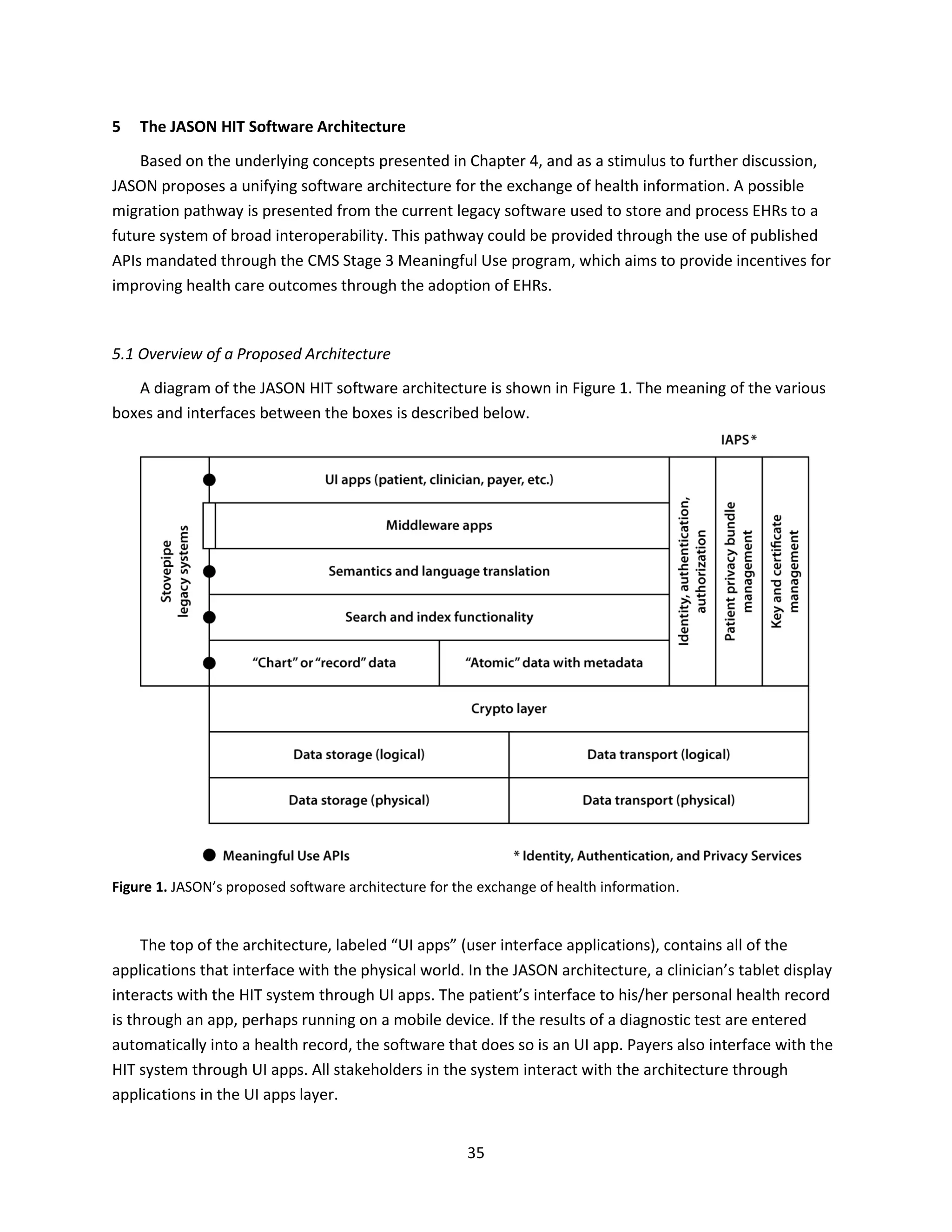
![36
Next consider the bottom three layers of the architecture, which define how patient data and
metadata are actually stored or transported between physical locations. A key design specification in the
JASON architecture is that all such data are encrypted, both in storage (at rest) and in transport (in
motion). It should be emphasized that data are not decrypted and then re-encrypted for the purposes of
transport and relocation. Data at rest or in motion can be meaningfully accessed only through a “crypto
layer,” and only when the crypto layer has been given, for one-time use in the current transaction, the
appropriate decryption keys. Put differently, data that reside below the crypto layer appear as just so
many random bits; they can be stored or moved, but (with strong cryptographic guarantees) they have
no interpretable meaning so long as the integrity of the files containing the data is preserved.
The adoption of these cryptographic principles as part of the architecture is completely agnostic as
to where the data are stored or how they are actually transported. The security remains in place
whether the data are in (or transported between) the cloud, or on unguarded machines in the offices of
solo practitioners, or anything in-between. A distinction is made between “logical” and “physical” stored
data and transported data as abstractions that make it simpler to upgrade storage and transport
mechanisms to new physical technologies as they become available in the future. The logical layers can
remain the same even as the physical instantiations change.
It remains necessary to discuss the four layers between the UI apps layer and the crypto layer, but
before doing so, it is useful to discuss the three vertical “pipes” of the architecture, shown at the right in
Figure 1. JASON terms these pipes Identification, Authorization, and Privacy Services, or IAPS. These IAPS
are similar to what PCAST termed Data Element Access Services [10], except that the usage here is more
neutral as to whether they are implemented across a network, in a single box, or anything in-between;
and more neutral as to the types of data that they service. The three IAPS are: (i) identity,
authentication, and authorization (IAA); (ii) patient privacy bundle management (PPBM); and (iii) key
and certificate management (KCM). These pipes capture the patient-centric nature of the architecture
and its capacity to implement fine grained permissions.
The functionality of the IAPS enables the top five layers (from the UI apps layer down) to process
actual patient data. The IAPS do this by mediating an interaction with the crypto layer and, when the
IAPS are satisfied that all policy requirements are met, providing to other layers the crypto keys that will
unlock pieces of data for immediate use in appropriate ways. These principles are illustrated in the first
six steps of the example patient query depicted in Figure 2.
The reason that IAA and PPBM are made separate functions in the JASON architecture is to allow
(though not require) their functions to be performed by different entities. The entity that patients
choose to trust to validate and enforce their patient privacy bundles might not, for example, be the
same entity that checks physician and hospital credentials. Similarly, the entity that actually holds the
crypto keys (and, for example, generates one-time session keys from longer-term cryptovariables) may
be different from both of the first two. Note that the IAPS themselves never access patient data, but
only judge the validity of requests and pass appropriate keys.](https://image.slidesharecdn.com/health-data-140720040559-phpapp02/75/A-Robust-Health-Data-Infrastructure-JASON-2013-39-2048.jpg)
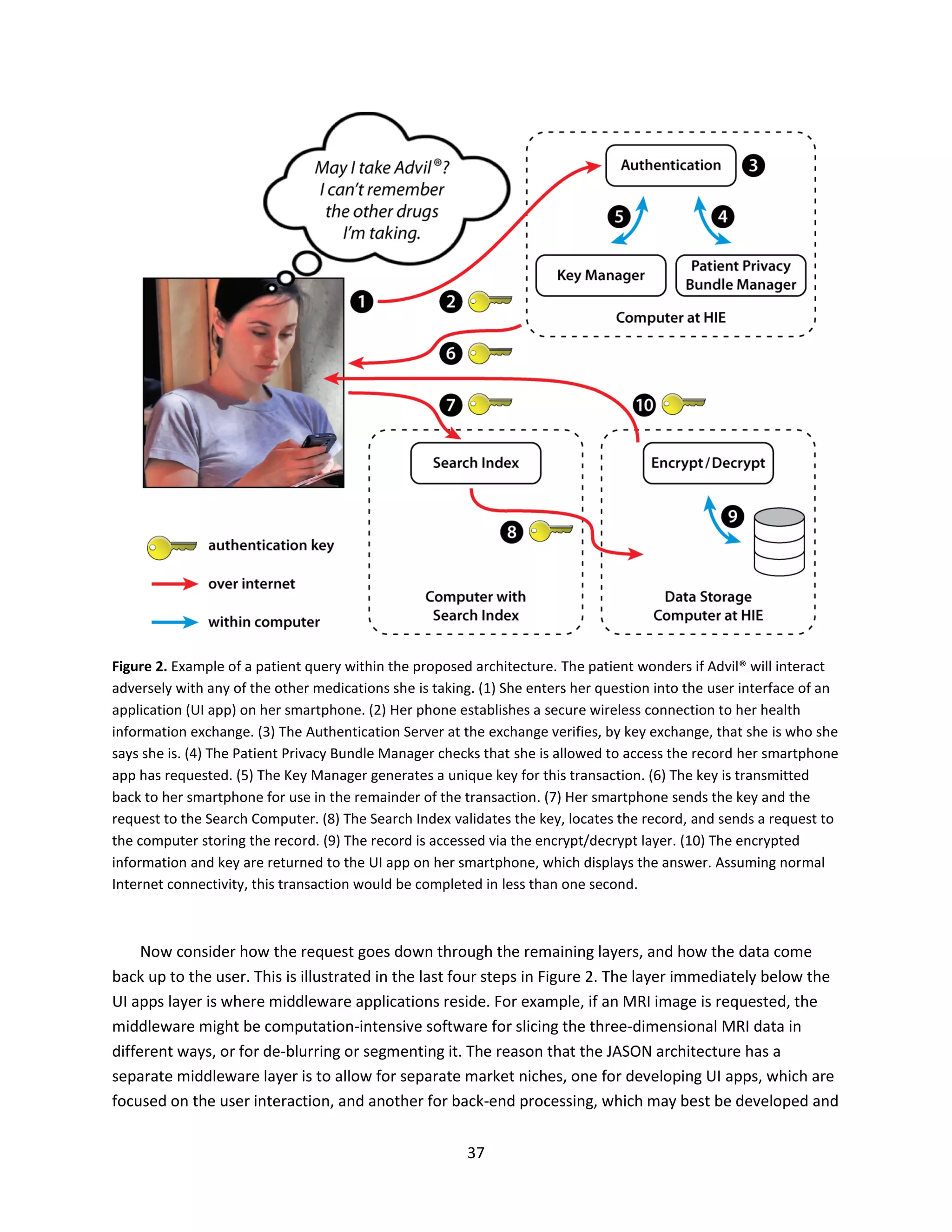
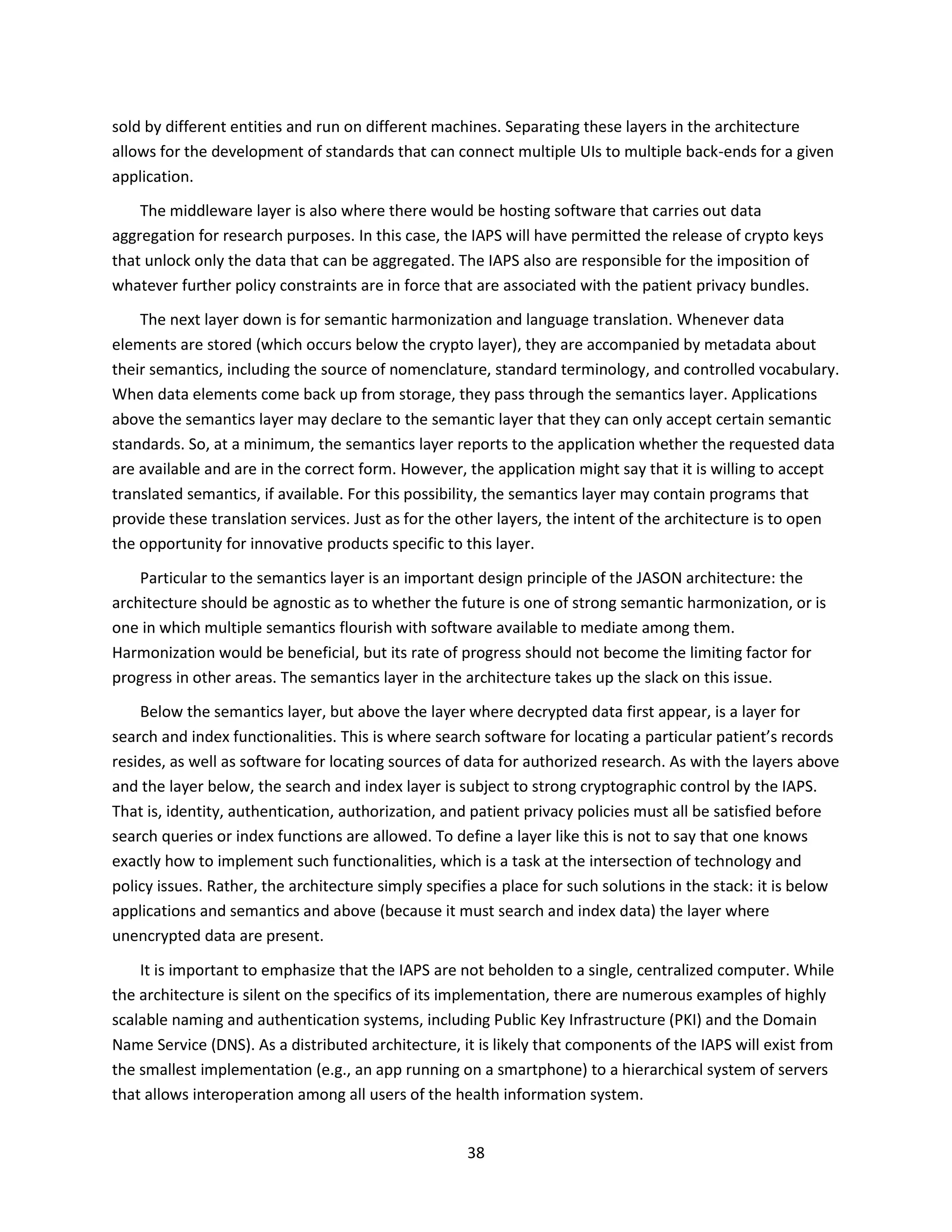
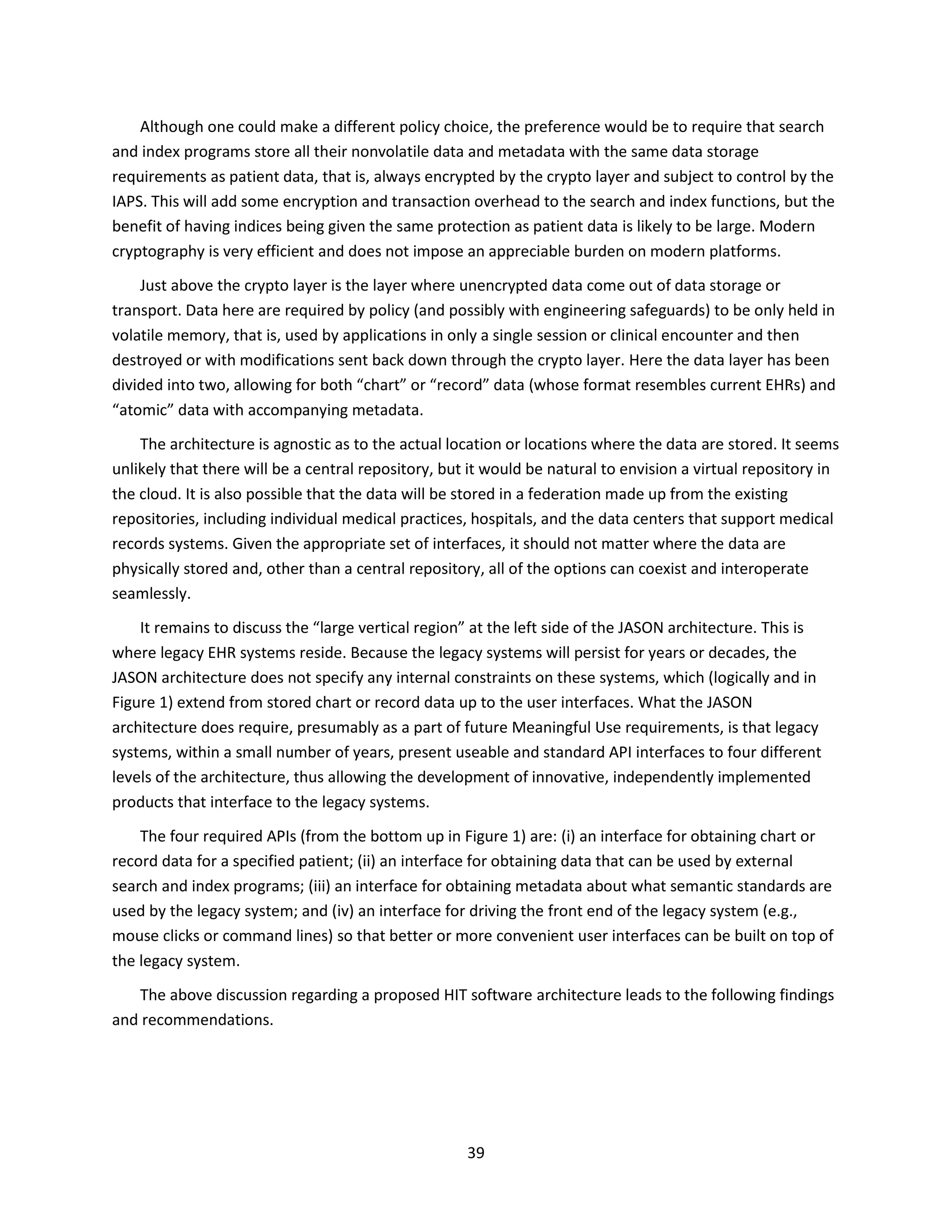
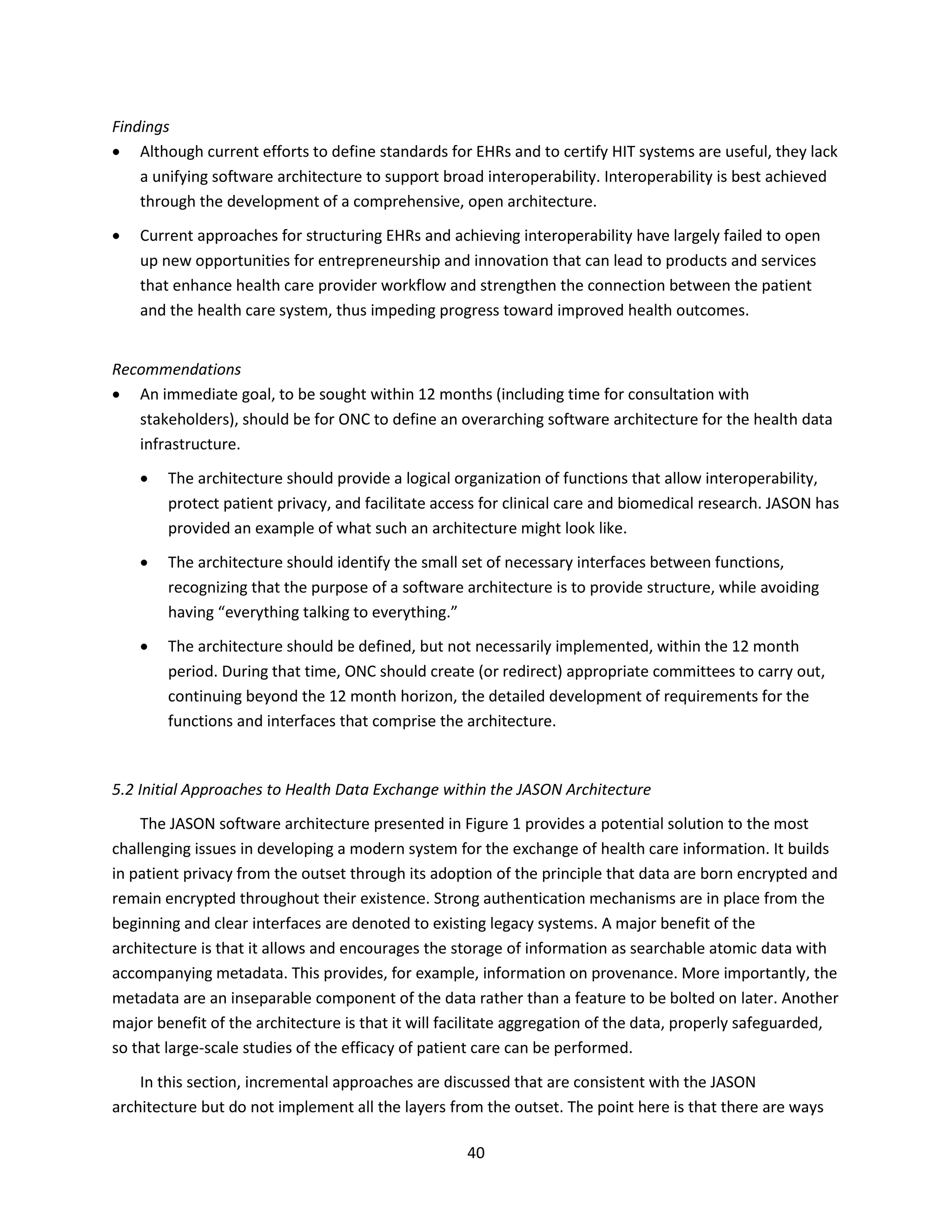
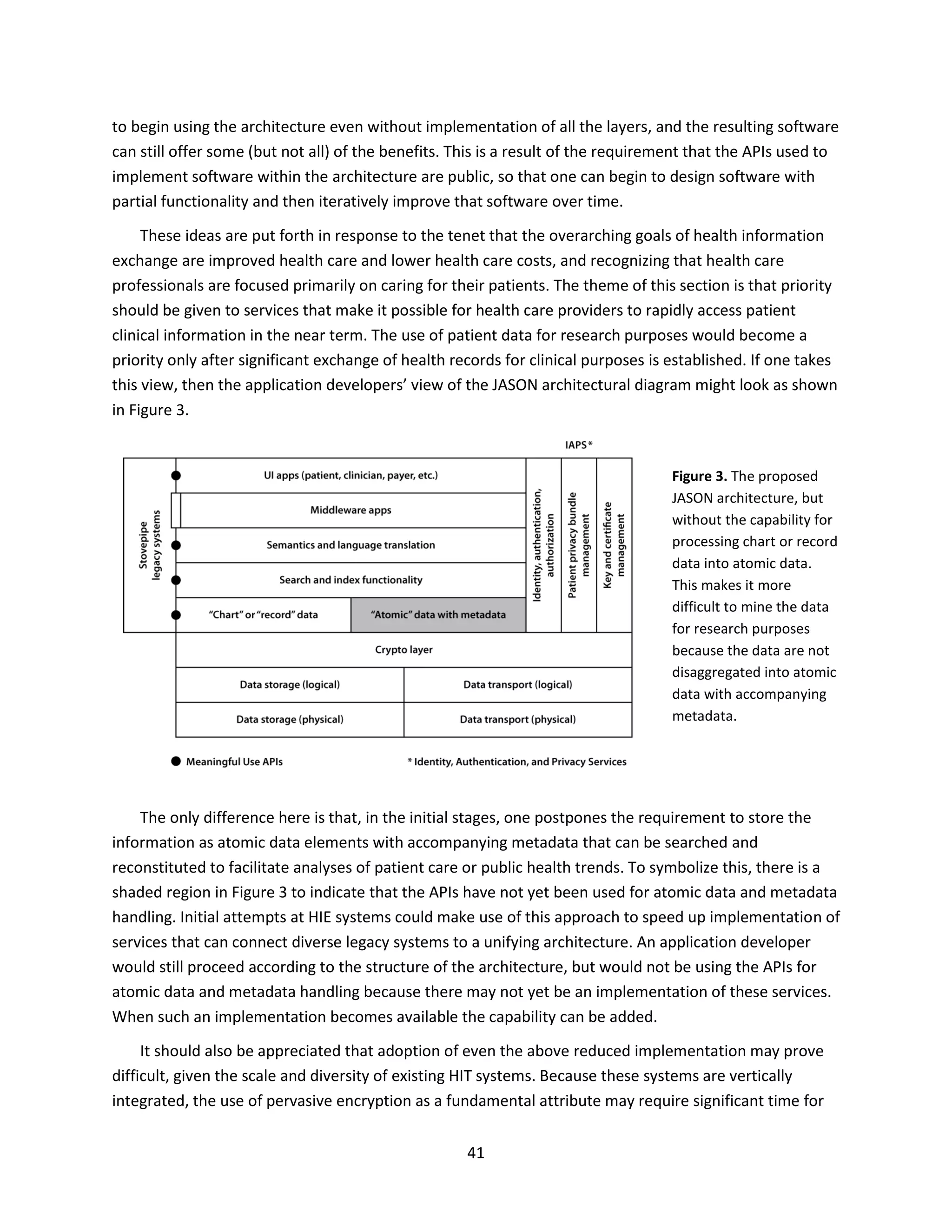
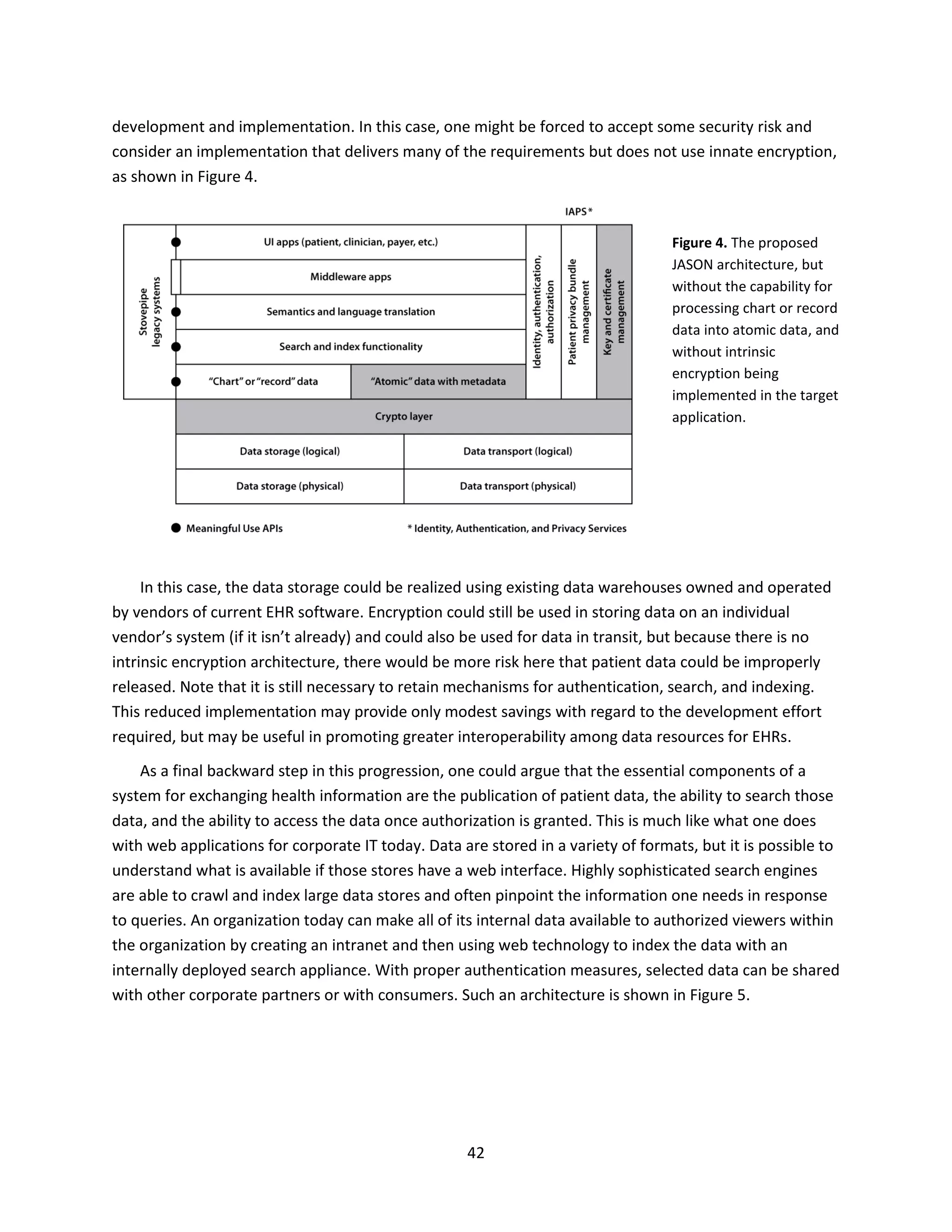
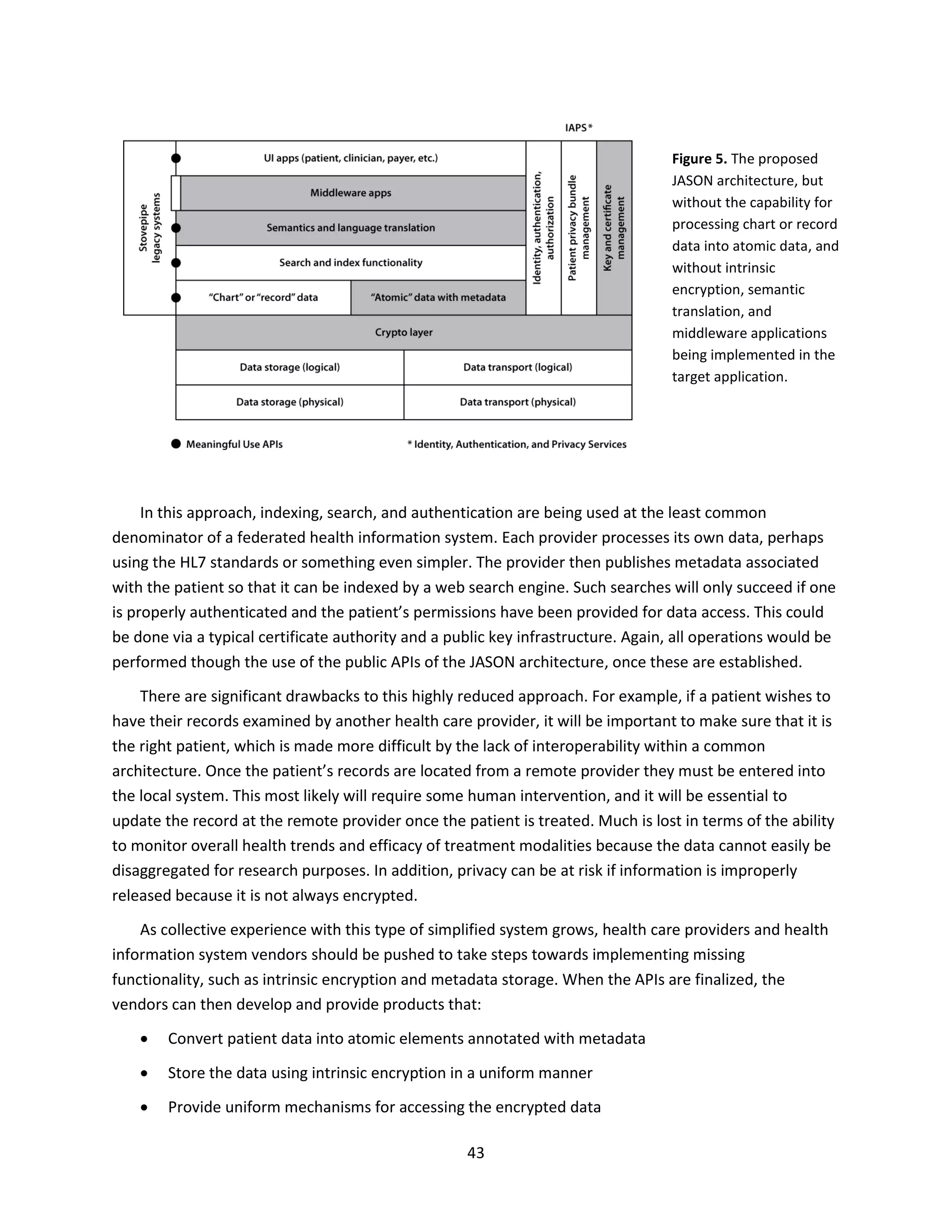
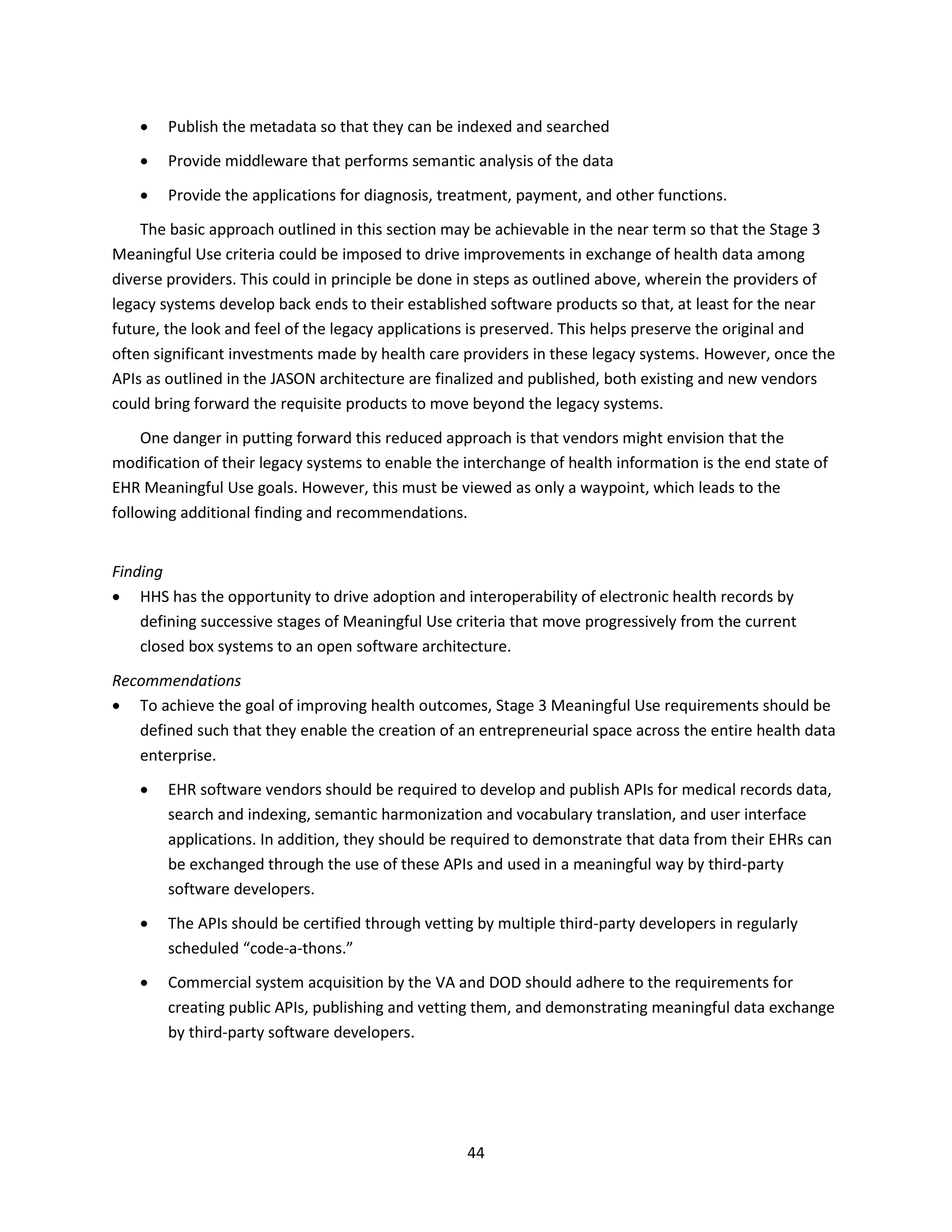
![45
5.3 Relationship to Other ONC Efforts
The ONC is currently sponsoring several efforts to develop interoperability and facilitate the
exchange of health information. Two of the main activities, CONNECT [41] and DIRECT [42], are
described here.
CONNECT is a software platform designed for the exchange of EHRs using the Nationwide Health
Information Network (NwHIN) standards. The software is open source and any health care provider can
use it to establish mechanisms for exchanging health information. It is meant to be the software glue
that binds that organization to a larger HIE. It can also be used to tie an HIE to a larger regional network.
CONNECT provides several services that can be used to enable exchange, including the following.
1. Core services gateway. These services are meant to run as part of existing Java-based web
application servers, such as WebSphere or GlassFish, and can be used to query the provider to
locate patient records and to retrieve documents once they are located. The gateway services also
provide mechanisms to authenticate various parties and to ensure that patient privacy choices are
respected.
2. Enterprise service components. These components can be used as part of the core services gateway
if the provider has not already implemented them. The components provided include:
Master patient index
Document registry
Authorization policy engine
Preferences manager
Audit log.
3. Universal client framework. Using the gateway services and enterprise service components, the
client framework enables the provider to create a system meant to sit at the edges of a HIE network.
CONNECT was started in 2006 through the joint efforts of 20 government agencies. At present, it is
in trial use by the VA, DOD, CMS, and Social Security Administration. So far, 69 medical software vendors
have written applications using the provided open source tools and a series of “connect-a-thons” have
been held to assess interoperability and to identify barriers. The goal is eventually to transition the
ownership of the open source tools from ONC to a private sector entity, but to retain the open source
policies.
Interoperability in this approach is achieved through the exchange of “direct messages.” Each direct
message is received by the web application server of a given provider and processed. The core gateway
services then are used to query the back end of a proprietary system. The vendor of the proprietary
system must write a software “adapter” that processes the messages through the vendor’s proprietary
system and replies to the querying system, again via the core services gateway. The adapter could be
developed using the service components provided from CONNECT or perhaps developed independently
by a vendor.](https://image.slidesharecdn.com/health-data-140720040559-phpapp02/75/A-Robust-Health-Data-Infrastructure-JASON-2013-48-2048.jpg)

![47
6 Research and the Health Data Infrastructure
Much of the promise of a robust health data infrastructure depends on benefits to be derived from
research making use of that infrastructure. That research includes clinical research aimed at discovering
new treatments and improving existing ones, and basic research aimed at revealing the underlying
mechanisms of human disease. The nature of both types of research is changing as more, and more
diverse, patient information is becoming available. The current system for accessing this information for
research purposes suffers from the same problems as for health care in general. The HIT software
architecture proposed in this report is consistent with the requirements for the use of health data for
research. In addition to the national research imperative, there is a strong interest in being to able to
access international health data for research. Thus it will be important to develop agreements that
address at the international level many of the same issues that are being addressed at the national level.
6.1 Relationship Between Research and Health Data
Basic biomedical research and clinical research have overlapping goals, which are to understand the
molecular mechanisms of human disease and to identify effective treatments for disease. In many cases
this can be reduced conceptually to understanding the relationships among the genotype, environment,
and phenotype of individuals. “Genotype” refers to the genome sequence of the individual, or to some
meaningful subset of that sequence such as the sequence variants (alleles) at known sites of
polymorphism in the human genome. “Phenotype” refers to the observable traits of that individual, for
example, their serum cholesterol level or their response to a particular therapeutic intervention.
“Environment” refers to everything other than genotype that affects the phenotype.
The ultimate goal of personalized medicine is to use combined genotypic, environmental, and
phenotypic data to tailor treatment to the individual. An example is the breast cancer drug trastuzumab
(Herceptin®), a monoclonal antibody directed against human epidermal growth factor receptor (HER2).
Trastuzumab is only effective in tumors in which HER2 is overexpressed (approximately 25% of breast
cancers [43]), usually as a result of amplification of the corresponding ERBB2 gene [44]. HER2
overexpression is assayed in biopsy samples by immunological methods or by testing for ERBB2
amplification by in situ hybridization. Identification of patients likely to be responsive to trastuzumab is
critical because the drug is expensive and treatment is associated with potential cardiotoxicity [45].
Another example is sensitivity to the anticoagulant warfarin (Coumadin®), which is influenced by
genotype at both the cytochrome P450 2C9 (CYP2C9) and vitamin K epoxide reductase complex 1
(VKORC1) loci [46]. Warfarin is the drug most commonly implicated in emergency hospitalizations due to
adverse drug events [47]. Prescription of warfarin currently does not require genetic testing, and it is still
common to determine empirically the effective dose for each patient. However, this is likely to change
as more data become available relating genotype to drug response.
The trastuzumab and warfarin examples illustrate how information of the sort that might be in an
EHR can directly influence treatment choices. These examples also illustrate how research into the basic
mechanisms of disease and therapeutic response increasingly makes use of genotypic and phenotypic](https://image.slidesharecdn.com/health-data-140720040559-phpapp02/75/A-Robust-Health-Data-Infrastructure-JASON-2013-50-2048.jpg)
![48
data to develop and test hypotheses. Because of the ethical and practical limitations on performing
patient research, most such studies rely strongly on statistical power to come to meaningful conclusions.
In the case of warfarin sensitivity, the strength of association between particular cytochrome P450
alleles and drug response was such that it could be conclusively demonstrated with only a few hundred
test and control patients. However, the trend is towards much larger studies, driven by the desire to
identify risk variants that have small but important effects, and that occur at a lower frequency in the
population. A recent landmark study on genetic factors affecting the risk of cardiovascular disease
assayed 200,000 individuals and identified 16 new risk factors [48]. Thus, there are two research-critical
areas that would immediately benefit from a robust health data infrastructure that takes into account
the needs of researchers:
Statistical power of studies: removing the ownership and interoperability barriers to sharing
data would facilitate clinical and basic research by increasing the size of datasets
Identification of rare variants: access to a larger, more detailed datasets will aid in the discovery
and characterization of informative rare variants, enhancing the understanding of disease
mechanisms.
6.2 Data Types in the EHRs of the Future
In assessing the potential for a robust health data infrastructure to support research, it is useful to
consider the nature of EHRs today and how this is likely to change as new technologies are developed
and implemented. The information in a typical EHR includes a combination of patient medical data and
administrative information about the patient and his/her health care provider. The medical data might
include demographic information, patient medical history and family medical history, current and past
medications, history of allergic reactions, vaccination records, laboratory test results, imaging results,
and so on. The administrative information might include billing information, insurance provider, dates
and nature of previous visits to the health care provider, referrals received, and so on. The challenge
posed by consolidating this disparate information in an interoperable EHR is large and is the main focus
of this study. The discussion below will emphasize how the technologies used in medical testing and
diagnosis are changing and how this will impact the EHRs of the future and the associated HIT
infrastructure.
There is a growing trend towards capturing large quantities of data associated with particular
aspects of patient phenotype, analyzing those data, and reporting relevant information back to the
patient. These come under the general heading of “omics” technologies, a designation derived from
genomics, the first of such data types. A brief description of the currently most important types of
“omics” information is provided below.
1. Genome sequence. The haploid human genome contains 3 x 109
base pairs of DNA. Humans are
diploid, so each person has two copies of their genome, one maternal and one paternal. These two
copies differ by approximately 0.1%, so it is necessary to sequence the DNA sufficiently deeply to](https://image.slidesharecdn.com/health-data-140720040559-phpapp02/75/A-Robust-Health-Data-Infrastructure-JASON-2013-51-2048.jpg)
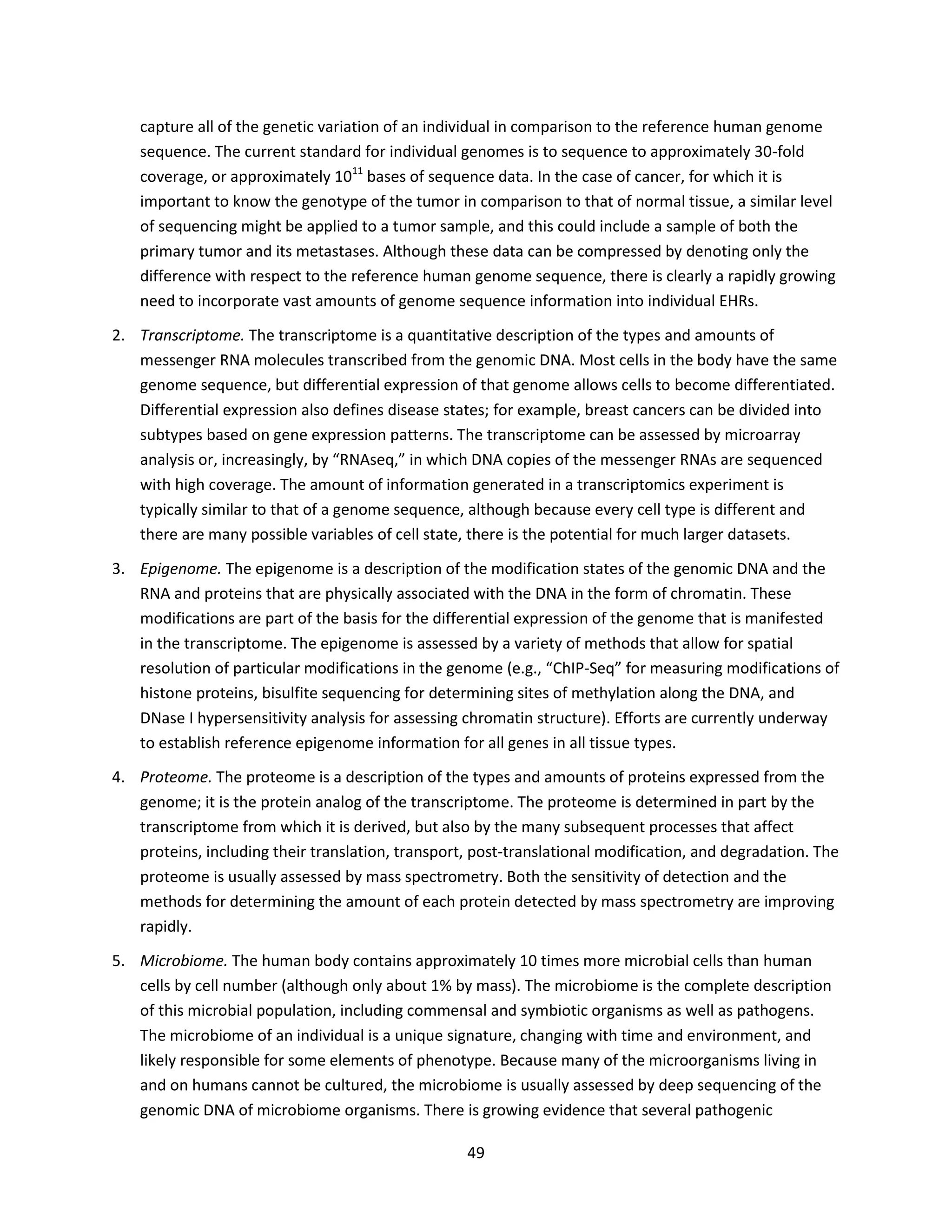
![50
conditions are due to aberrant states of the microbiome, some of which can be corrected by altering
or replacing an individual’s microbiome.
6. Immunome. The immunome is a description of the state of the immune system of an individual,
focusing on the diversity of immune responses based on past exposures. In a narrower sense, such
information has long been a part of health records. For example, the Mantoux (or PPD) skin test,
and its predecessor the tuberculin tine test, assess the immune response to Mycobacterium
tuberculosis antigens as a measure of previous exposure to this pathogen. High-throughput methods
now allow testing for reactivity to thousands of antigens at once, in combination with deep
sequencing to characterize the genome rearrangements that occur in each immune cell and define
its reactivity.
JASON’s assessment is that each of these “omics” approaches to characterizing individuals will be
important elements of health care in the future, and therefore that a robust health data infrastructure
must be able to incorporate the corresponding data and to facilitate sharing the data for research
purposes. It is important to be aware that these types of data, alone or in combination, can provide a
sufficient level of detail to uniquely identify a person in the world population. This should be obvious
based on the Combined DNA Index System (CODIS) used in criminal forensics, which relies on 13
polymorphic loci in the human genome, which is a minute subset of the entire genome. Combining
genome information with other types of metadata and large publicly available datasets, it has been
possible to re-identify individuals in genetic studies using de-identified data. Failsafe de-identification is
already impossible, and it is likely to become more difficult to avoid re-identification in the future given
the increasing specificity of medical data. Therefore, other means of mitigating privacy risks must be
pursued, with the goal of protecting patients from discrimination, and fostering confidence in the
research enterprise. This issue is discussed in detail in section 6.3, below.
There is a growing trend on the part of researchers to seek phenotypic information through surveys
and on the part of individuals to gather personal health data relevant in digital form. Both are likely to
be important contributors to EHRs and fall in the category of self-reported data. For self-reported
surveys, there have been several recent examples in which relatively simple questions regarding
phenotype and family medical history were combined with genomic information in genome-wide
association studies to identify loci involved in human traits [49–51]. There is some evidence that
anonymous self-reporting is more accurate than information gathered in consultation with a physician,
presumably because some patients are uncomfortable revealing personal information directly to
another individual.
In a further step away from involvement of trained medical personnel in data collection, there is a
growing market for wearable fitness trackers and smartphone-based apps that generate health-related
data continuously or on demand. The self-reported data from surveys and personal monitors will vary
widely in quality and utility for research, but will be an increasingly important source of phenotype
information. As for “omics” data, the health data architecture should be tolerant of inputs from these
self-reported sources, and allow for indicators of uncertainly in the data based on the means of its
acquisition.](https://image.slidesharecdn.com/health-data-140720040559-phpapp02/75/A-Robust-Health-Data-Infrastructure-JASON-2013-53-2048.jpg)
![51
It is useful to consider how these new types of data might be used for research in the context of a
broader system for sharing health data. There are several instructive examples already underway at the
NIH, VA, Wellcome Trust, and Kaiser Permanente. However, a program at Vanderbilt University Medical
Center is perhaps the most advanced with respect to biomedical research. The Vanderbilt BioVU
program is a large program that establishes a biobank of DNA samples for nearly all patients entering
the Vanderbilt hospitals and clinics, and matches the banked samples with EHRs that have been de-
identified by standard methods [40]. This is an opt-out program, meaning that patient genetic material
is acquired and added to the biobank unless the patient specifically indicates a desire not to participate
after having been given a brief description of the potential research uses of those samples. Remarkably,
only about 3% of patients opt-out [40].
BioVU began collecting samples in 2007 and now has 167,250 samples banked. Access to BioVU is
limited to Vanderbilt researchers, and the Vanderbilt genomics group has developed new analytical
tools to make use of this treasure trove of data. An example is their use of combined EHR and genomic
data to carry out a phenome-wide association study, analogous to the more common genome-wide
association study [52]. The principle, which is broadly applicable to any similar large dataset, is to use
indicators of phenotype to identify traits that are associated with a particular genetic variant. To
standardize phenotype descriptors, the Vanderbilt researchers used the International Classification of
Disease (ICD9) billing codes in EHRs as indicators of the conditions individuals might have. They then
sought statistically significant association of those phenotypes with a particular genotype. This approach
has successfully identified several connections between diseases and single-nucleotide genetic
variations [53].
This discussion about health data for research leads to the following finding and recommendation.
Finding
The biomedical research community will be a major consumer of data from an interoperable health
data infrastructure. At present, access to health data is mostly limited to proprietary datasets of
selected patients. Broad access to health data for research purposes is essential to realizing the
long-term benefits of a robust health data infrastructure.
Recommendation
The ONC should solicit input from the biomedical research community to ensure that the health
data infrastructure meets the needs of researchers. This would be best accomplished by convening a
meeting of representative researchers within the immediate (12 month) time frame for architecture
definition.
6.3 Data Access
There is a natural tension in the research community between the desire for open access to health
data, with its advantages for increasing the power and relevance of studies, and the desire to receive
individual credit for scientific advances by restricting access to a smaller set of collaborating researchers.](https://image.slidesharecdn.com/health-data-140720040559-phpapp02/75/A-Robust-Health-Data-Infrastructure-JASON-2013-54-2048.jpg)
![52
JASON notes that a similar tension existed at the beginning of large-scale sequencing of the human
genome and the genomes of various model organisms. In those cases, open access to complete genome
sequence information threatened the old model of research in which a researcher would identify and
characterize a single gene based on some property of interest, using the relatively arduous technology
of the time. Based on this perceived threat, many researchers opposed the large and expensive
sequencing projects. However, once it was appreciated that open access to genome sequences could
lead to a new and much more productive model for research in which many genes and their
interrelationships could be characterized, the sequencing effort was embraced by the research
community. In hindsight, it is now clear that open access to sequence information revolutionized
biomedical research and created rich entrepreneurial opportunities. JASON believes that a revolution of
similar scale will be driven by open access to electronic health data, and that the research community
will fully embrace this once a plausible architecture for access exists and the potential benefits for
research become apparent.
There is a second tension for data access regarding the balance between patient privacy and the
potential societal benefit of access to patient data. In an effort to protect patient privacy, a general
practice in biomedical informatics has been to “de-identify” the data before sharing them with
researchers for analysis. De-identification (de-ID) is the process whereby strong identifiers are
selectively removed from the individual records in the dataset, for example, the patient’s name,
address, and social security number. Alternatively, data may be obfuscated by replacing strong
identifiers with more generic, or operationally ambiguous, information. However, as many in the
biomedical research community have come to realize, true de-ID cannot be achieved by simply
redacting strong identifying information. A person is often uniquely represented in his/her health
records by a constellation of data that are specific to that individual. Patient records carry a sufficient
amount of weakly identifying information that de-ID can almost never be guaranteed. Re-identification
(re-ID) has been shown to succeed on other types of data as well, and has spawned an entire industry of
consumer tracking and web-based data analytics.
In the biomedical arena, partial and complete re-ID has recently been demonstrated using the
published DNA sequences of nominally anonymous individuals who participated in the Personal Genome
Project. Their published DNA sequences were cross-correlated with information obtained online by
querying recreational genealogy databases, employing a custom algorithm [54]. The available genomic
information was first used to associate an unknown individual with his or her family tree, then additional
sequence information was used to pinpoint the individual.
The prospects for successful re-ID are expected to grow in the future as much greater amounts of
information-rich data are included in EHRs. As whole genome sequencing becomes routine, each person
will be uniquely represented in his/her health data. Transcriptome, epigenome, proteome, microbiome,
and immunome data will provide additional potentially uniquely identifying information. Health data
may also be accompanied by geolocation information, such as data generated by smartphone apps.
Soon it will no longer be feasible to carry out meaningful de-ID without redacting much of the medical
information itself.](https://image.slidesharecdn.com/health-data-140720040559-phpapp02/75/A-Robust-Health-Data-Infrastructure-JASON-2013-55-2048.jpg)
![53
JASON finds that de-ID is not a viable approach for ensuring patient privacy going forward.
Furthermore, de-ID is highly undesirable for clinical and basic research because it impedes discovery in
two significant ways. First, there is the problem of misidentification (mis-ID), whereby an individual’s
health record, in the absence of sufficiently strong identifiers, is mistakenly duplicated, merged, or
conflated with another person’s health record. This corrupts many types of analyses by destroying the
statistical independence of the data. The second major problem for research is data loss. Data that are
redacted or obfuscated in the de-ID process may lose information that is useful for discovery. For
example, an individual’s home address may be very useful in epidemiological research, such as in
tracking communicable diseases or pinpointing the source of toxic exposures.
A straightforward way to prevent mis-ID problems is to associate a unique identifier (UID) with each
EHR. There is currently substantial opposition to implementing a national system for assigning UIDs for
health care. However, alternatives to a true UID system are routinely implemented. All major health
care providers assign an ID that is unique to the patient, but is only operable within their own system.
Smaller health care providers often use the patient’s social security numbers or a number supplied by
the patient’s health insurance provider. Problems can arise with mis-ID within a health care
organization, and are much more common when trying to combine data from different organizations.
Ironically, algorithms for re-ID may be useful in disambiguating these inconsistencies.
With regard to problems of data loss for research, it would be preferable to avoid any redaction or
obfuscation of health care data and provide some other means to protect patient privacy and ensure
data security. JASON recommends moving towards a security model where large datasets may be
collected for research purposes complete with identifying information, with the caveat that any patient
identifying information would subsequently be removed from the results of the research analyses. The
results would be de-identified analogous to the way results from clinical trials are de-identified; the
clinician is fully aware of the patient’s identity during the course of the trial, but the results of the trial
contain no uniquely identifying information.
The HIPAA Privacy Rule protects patient health information in the clinical setting. In the research
setting it would be necessary to establish real or virtual data enclaves (“walled gardens”) where the
unanonymized data can be analyzed in a protected setting. Successful examples of such data enclaves
already exist for other types of sensitive data [55,56]. Because there can be no guarantees against re-ID,
and because individual health data are highly sensitive, it must be recognized that any attempt to
balance the private and public uses of medical data necessarily involves compromise. It would be
preferable to move towards a system like HIPAA, which penalizes by law any abuses of data, rather than
attempting to perpetuate the fallacy that the data can truly be anonymized.
Data access models that feature a fine granularity of permissions, such as the patient privacy
bundles for atomic data and metadata within the JASON architecture, offer maximal flexibility in
allowing the patient to specify the balance between privacy and perceived benefit for research. Fine-
grained permissions will facilitate whatever security policy is eventually adopted for the exchange of
health information, but without rendering the records unsuitable for research purposes. These](https://image.slidesharecdn.com/health-data-140720040559-phpapp02/75/A-Robust-Health-Data-Infrastructure-JASON-2013-56-2048.jpg)
![54
permissions make it possible to adapt access to all or part of an individual EHR easily and without
modification of its contents. This discussion leads to the following finding and recommendation.
Finding
The data contained in EHRs will increase tremendously, both in volume and in the diversity of input
sources. It will include genomic and other “omic” data, self-reported data from embedded and
wireless sensors, and data gleaned from open sources. Some types of personal health data,
especially when combined, will make it possible to decipher the identity of the individual, even
when the data are stripped of explicit identifying information, thus raising challenges for
maintaining patient privacy.
Recommendation
The adopted software architecture must have the flexibility to accommodate new data types that
will be generated by emerging technologies, the capacity to expand greatly in size, and the ability to
balance the privacy implications of new data types with the societal benefits of biomedical research.
6.4 International Nature of Research
The US population is less than 5% of the world population, but is very diverse in terms of
representation of racial and ethnic groups. Aside from Native Americans, all US residents are relatively
recent immigrants when compared to populations in Africa and Europe. Thus the genetic makeup of an
individual in the US is as likely to closely resemble that of an individual outside the US as one inside. This
argues that the US has advantage in carrying out biomedical research of global import because it can
draw on the genetic diversity of its people. It also argues that it ultimately will be beneficial to achieve
international interoperability for the sharing of health data. The ability to access international health
data will aid the US research community in the ways described above for the benefits of increased
numbers, and will aid international health care by making use of what is learned from the US
population.
There are serious challenges to developing international interoperability that mirror those for a US
national system, but are amplified by differences in national priorities, privacy expectations, legal
systems, medical and insurance infrastructure, and more. The genomics research community has similar
concerns, although on a smaller scale, and provides an example for how to proceed. Researchers at
institutions in 40 countries have initiated a global alliance with the common goal of enabling the secure
sharing of genomic data. This alliance is non-governmental and not-for-profit. In the letter of intent for
this alliance, its members have outlined a set of core principles, which are largely applicable to the
broader sharing of health data [57]:
Respect data sharing and privacy preferences of participants
Transparency of governance and operations
Accountability for best practices in technology, ethics, and outreach](https://image.slidesharecdn.com/health-data-140720040559-phpapp02/75/A-Robust-Health-Data-Infrastructure-JASON-2013-57-2048.jpg)
![55
Inclusivity based on partnering and building trust among stakeholders
Collaboration based on shared information to advance human health
Innovation in developing an ecosystem that accelerates progress
Agility by acting swiftly to benefit those suffering with disease.
Agreement on these core principles provides a framework for developing international protocols for the
exchange of biomedical data, as described in detail in the position paper from this group [58].
These considerations lead to the following finding and recommendation.
Finding
The US population is highly diverse, reflecting much of the diversity of the global population.
Therefore, important research findings applicable to Americans are likely to come from shared
access to international health data. Currently there is no coherent mechanism for accessing such
data for research.
Recommendation
The ONC should exert leadership in facilitating international interoperability for health data sharing
for research purposes. The genomics community is already engaged in such efforts for the sharing of
sequence data, and the ONC should consider adopting a similar process.
6.5 Electronic Health Records and Health Care Fraud
It may seem out of place to include a section on health care fraud in a chapter promoting research.
However, the same data access issues and health data analysis requirements that pertain to research
underpin the ability to carry out fraud detection. In both case, broader access to health data and new
health data analytic methods are needed.
The FBI estimates that the total annual loss due to health care fraud exceeds $80 billion [59]. In
addition to this loss, the Government Accounting Office reported a federal government allocation of at
least $0.6 billion to investigate and prosecute alleged health care fraud cases in 2011 [60]. In their 2012
annual report on health care fraud, the Health Care Fraud and Abuse Control Program noted that the
federal government won or negotiated approximately $3 billion that year in fraud judgments and
settlements [61]. Thus only a small fraction of the money lost to health care fraud is being recovered by
existing fraud discovery and fraud recovery methods. This creates a substantial opportunity for
exploiting EHR data to reduce costs from health care fraud.
The sources of fraudulent activities in health care are various and include patients (or fake patients),
health care providers [62], health care equipment manufacturers, pharmaceutical companies [63],
organized crime, terrorist groups, and foreign governments [64]. Therefore, the design of EHR systems
should take into consideration what data could be collected to defend against or respond to fraud.
Regardless, large collections of health care data likely could be analyzed in innovative ways to reveal](https://image.slidesharecdn.com/health-data-140720040559-phpapp02/75/A-Robust-Health-Data-Infrastructure-JASON-2013-58-2048.jpg)
![56
normal patterns of patient care and corresponding expenditures. Patterns outside these norms could
receive special attention and require validation for payment by human investigators, as is common
today for private medical insurance reimbursement.
Paradoxically, initial launches of local and regional EHR systems have generally been met with
increases in health care costs, rather than the decreases one might expect if fraudulent activity were
more transparent [64,65]. Two emergent phenomena can explain some of these unexpected increases.
Electronic records can more easily be “cloned,” whereby a patient is charged for services not received
because the provider found it easy to copy-and-paste a record from a different patient. Also, it is easier
for providers to exaggerate the level of care or the severity of a disease by “upcoding,” which may
involve simply clicking a box to trigger a higher billing charge. A combination of clearly articulated
expectations for appropriate billing, training on the appropriate use of EHRs, and the use of EHR data
analytics will be required to reduce these sources of unnecessary health care costs.
Beyond the more insidious problems noted above, certain abuses of the health care system should
be readily identified by electronic analysis of EHRs. However, little effort is being made today to use
EHRs to identify and reduce even the simplest of health care fraud tactics. In 2012 HHS announced a
public-private partnership to prevent health care fraud [66]. This initiative includes the long-range goal
to “use sophisticated technology and analytics on industry-wide health care data to predict and detect
health care fraud schemes.” In opposition to this intended goal, the Office of Inspector General recently
terminated 400 of its fraud detection staff, which corresponds to about one fourth of its employees in
this area [67]. This reduction in staff is likely to reduce actions taken by CMS in response to their existing
predictive analytics software that is designed to spot patterns of fraud.
Clear indications of fraud should be easy to identify and simple actions can be taken to eliminate
their sources. For example, delivery of disease-specific health care products to patients who have not
been diagnosed with the corresponding disease could be uncovered by matching claims to diagnoses in
EHRs. A major target for fraud detection could be the fraudulent prescription of schedule II drugs
(medically-useful drugs of abuse such as opiates, sedatives, and stimulants). Inappropriate prescriptions,
usually made with abnormally high frequency by a small number of doctors, can be identified by the fact
that no prior medical exam has been completed for the “patient.” Also, schedule II drugs cannot be
refilled without a new prescription (with exceptions for patients in long-term care facilities or hospice
care), and therefore associated claims should not be accepted. The CDC reports that schedule II drugs
have replaced illicit drugs as the leading cause of death by drug overdose [68]. Therefore, reducing
schedule II drug fraud will have a positive effect on both health care finances and the major societal
problem of drug abuse.
An indirect mechanism of health care fraud is stealing EHR data that can be monetized. As health
care records become electronic, there is greater risk that large amounts of data can be stolen during a
single operation. Unlike conventional credit card or ID theft, a person’s health history cannot be
cancelled or restored to secrecy if publically disclosed, making the problem distinct from other types of
data security challenges. Also, given that some diseases are hereditary, the disclosure of one person’s
medical records might allow someone to realize financial gain by predicting the disease risk of the](https://image.slidesharecdn.com/health-data-140720040559-phpapp02/75/A-Robust-Health-Data-Infrastructure-JASON-2013-59-2048.jpg)
![57
victim’s relatives. It is possible that cyber criminals may be more likely to target someone for identity
theft if their immutable personal history is already known. A complete medical record for an individual
could be used to submit fraudulent medical bills, in this instance using a fake patient with a real and
verifiable medical history.
Only modest innovation is needed to identify some of the examples of health care fraud noted
above. However, the development of more sophisticated data analytics would allow investigators to
uncover more obscure patterns of fraud. Moreover, as fraud detection strategies improve, innovative
fraudsters will be forced to find new ways to exploit the health care system for financial gain. Therefore,
JASON recommends that collections of de-identified EHR data be made available for researchers to
develop strategies and algorithms to uncover subtle patterns indicative of fraud, and to adapt these
algorithms to the changing tactics of fraud perpetrators.
Finding
Electronic access to health data will make it easier to identify fraudulent activity, but at present
there is little effort to do so using EHRs.
Recommendation
Large-scale data mining techniques and predictive analytics should be employed to uncover
signatures of fraud. A data enclave should be established to support the ongoing development and
validation of fraud detection tools to maintain their effectiveness as fraud strategies evolve.
6.6 Modeling and Simulation
This chapter concludes with a few words about modeling and simulation in the context of EHRs and
the electronic exchange of health information. Modeling and simulation has been proposed as a
valuable technology to explore models and scale-up of the health data infrastructure [7,69]. However,
efforts to date have tended to focus on modeling health care delivery of individual entrerprises [70–72],
rather than that of a regional or national interoperable system. The approaches use multi-level
simulations, frequently combined with agent-based models to optimize medical outcomes. Large
amounts of data are collected on the various components of a health care enterprise, and rules
describing the behavior of patients, health care providers, and insurers are collected to inform the
simulations. In addition, information regarding disease models may be incorporated so that the
outcomes of various treatment strategies can be considered.
These types of analyses can have great value in guiding how providers manage various medical
conditions, and are a good example of the potential utility of HIT for improving health care. However,
these models are only as good as the data that informs them. It is therefore all the more urgent that
high quality, searchable medical data be made available and that a broadly interoperable software
architecture to handle such data be put in place.](https://image.slidesharecdn.com/health-data-140720040559-phpapp02/75/A-Robust-Health-Data-Infrastructure-JASON-2013-60-2048.jpg)
![58
7 Concluding Remarks
This report has expressed disappointment in current US progress towards the creation of a robust
health data infrastructure, while praising ONC and HHS for their persistence in trying to tackle one of the
most vexing problems of today’s society. JASON believes that the two overarching goals, improved
health care and lower health care costs, can be achieved by moving to EHRs and the comprehensive
electronic exchange of health information. JASON has provided a path toward realizing the promise of a
robust health data infrastructure through the development of a unifying HIT software architecture that
adheres to the following core principles, all embodying a focus on the patient:
Be agnostic as to the type, scale, platform, and storage location of the data
Use public APIs and open standards, interfaces, and protocols
Encrypt data at rest and in transit
Separate key management from data management
Include with the data the corresponding metadata, context, and provenance information
Represent the data as atomic data with associated metadata
Follow the robustness principle: be liberal in what you accept and conservative in what you send
Provide a migration pathway from legacy EHR systems.
The path forward must also include full access to health data for clinical care, public health, and
biomedical research. This will require building the public’s trust. Patients must believe that their privacy
protection can be balanced with the perceived social benefit of access to their data. In addition, the path
forward must open an entrepreneurial space for innovation in the development of tools and approaches
for the delivery of health care.
This report will close with a few comments about improving the nation’s health and its relevance to
national security. Improving the health of Americans is a worthy goal in its own right, and from a
national security perspective it is important to have an accurate assessment of the current health and
potential health vulnerabilities of the population. A robust health data infrastructure would help to
provide that barometer, and the National Academy of Engineering has put this forward as one of its
grand challenges for the 21st Century [73]. The health of the nation also has implications in terms of
military readiness and effectiveness [74], although this discussion focuses more specifically on
implications related to the exchange of health information.
The security of the nation is tied to its economic vitality and ability to withstand economic
disruption. An integral part of economic growth and stability is continued innovation, which requires a
healthy and productive population to explore new opportunities for innovation. The US is the world
leader in biomedical research and technology, as well as computer science and information technology.
The nexus of these two areas promises to be fertile ground for business and economic development,
and that development will be fueled by health data, especially if the data can be harnessed in a
coordinated manner. As discussed in section 6.4, the US has a special advantage compared to other](https://image.slidesharecdn.com/health-data-140720040559-phpapp02/75/A-Robust-Health-Data-Infrastructure-JASON-2013-61-2048.jpg)
![59
more ethnically homogenous countries: it is a genetic melting pot that can be a crucible for discoveries
related to personalized medicine and the genetic basis of disease. New business opportunities exist in
these areas, and the vendors of legacy EHR systems, once mandated to open their systems to broad
interoperability, will be especially well poised to move toward a business model of innovation rather
than entrenchment.
In a time of crisis, having a strong health data infrastructure will help to keep the people and
responsible parties informed about current health conditions and available treatment options. A crisis
may necessitate temporary changes in health care services, which can be better managed with better
information. Hurricane Katrina provided an example of what can go right and wrong with medical care in
an emergency. The VA health system was able to transfer electronic records and refer patients to
hospitals and clinics outside the New Orleans area even before the evacuation began. Of 40,000 VA
patients in the affected area, approximately 20,000 accessed their health records in the immediate
aftermath of the disaster [75]. Those outside the VA system did not fare so well. Quoting Brown et al.
from the American Journal of Public Health [75]:“The nation will probably never have complete data on
how many evacuees were unable to continue their medical regimens without interruption and what
consequences resulted.”
Following a natural disaster, act of terrorism, or military attack, first responders will be able to
operate more efficiently if they have rapid access to the names, locations, and medical history of
persons who may need immediate or specialized attention. At present, first responders operate mostly
in reactive, rather than proactive, mode when entering an area of devastation. Patients are triaged and
their medical information is collected on the fly. It would be more effective to know in advance, for
example, how many people will require dialysis within the next 72 hours, who might require vaccination
against tetanus, who can and cannot tolerate first-line antibiotics, and so on. An efficient system for the
exchange of health information also would help support the CDC in identifying a natural disease
outbreak or biological attack by tracking occurrences of exposure-related symptoms across the nation.
In the case of a communicable agent, rapid access to information will enable faster decision making and
response, thereby helping to mitigate the medical and societal consequences of the contagion.
Improved integration and analysis of health information could help prevent violent attacks by lone
individuals. The perpetrator of suicide, domestic violence, or mass killing is often revealed after the fact
to have had a long and troubled involvement with mental health professionals and other health care
providers. If these dots can be connected in advance, there is the possibility that some tragedies could
be avoided. Of course, this treads on complex legal and ethical issues related to the presumption of
innocence and the right to privacy of medical information. However, the duty to warn (so-called
“Tarasoff laws”) requires a clinician to report a patient’s behaviors that may pose imminent danger to
him/herself or others [76]. Even apart from specific cases, a statistical study using historical data could
ask what indicators are most predictive of violent behavior and with what time lag before the violent
event occurs.
Finally, the security of the nation relies its cadre of first responders, armed services personnel, and
health care providers, all of who themselves must be in good health and fit for duty. Lifestyle illnesses,](https://image.slidesharecdn.com/health-data-140720040559-phpapp02/75/A-Robust-Health-Data-Infrastructure-JASON-2013-62-2048.jpg)
![60
such as diabetes, obesity, and addictive disorders, reduce the pool of citizens who are able to serve in
these capacities and reduce the overall readiness of those who do serve. Electronic health care
monitoring coupled with EHRs is already lessening the incidence of obesity, especially in children [77].
Wider application of these methods should help to improve the nation’s health. Maintaining a healthy
population will improve the security of the nation and the lives of its people. Ultimately this is the
promise of a robust health data infrastructure.
JASON is grateful to have had this opportunity to examine the challenging and important topic of
enhancing the adoption and interoperability of EHRs. This report has advanced many general principles,
as well as a specific example an HIT software architecture to facilitate migration to a software
ecosystem, with a diversity of products and apps, that fosters innovation and entrepreneurship. JASON
believes that now is time to define such an architecture, leveraging the opportunity to specify CMS
Stage 3 Meaningful Use requirements to drive implementation. A fundamental precept of medicine is:
“Above all, do no harm.” A software architecture that is broadly tolerant of different scales, input types,
and sites for data storage and processing offers a sure pathway, and one that will be open to future
innovation. Patients and health care providers will be in a position to choose which particular
implementations within the architecture have the most utility for their needs.](https://image.slidesharecdn.com/health-data-140720040559-phpapp02/75/A-Robust-Health-Data-Infrastructure-JASON-2013-63-2048.jpg)
